|
|
|
|
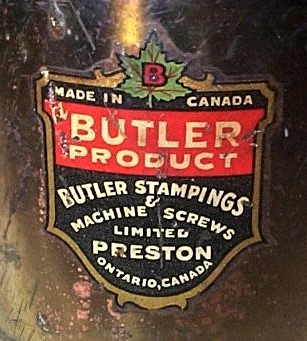
|
Butler Blow Torches:
A History
|
Updated
June 2023 See Revisions
|
|
And a
background to other
Canadian Blow Torch manufacturers & suppliers
Welcome to this
website article. Hopefully it will be of
interest to anyone who had a personal or working connection with one of the
Butler family, the Butler company, or to anyone with an
interest in Canadian Blow Torches, or Blow Torches in general.
Coleman enthusiasts will
hopefully also find the article of interest.
|
|
Updates
include a 1948 photograph of the Butler
staff & their offices / works.
|
|
Butler
Blow Torches: A History
|
| Introduction |
The
range of models produced by Butler for themselves & others |
William
Butler & William H Butler
Early years, Hamilton, Ontario
|
Start
of Blow Torch manufacture, Preston, Ontario
|
War
Years |
| Post
War / 1950s |
1960s
(& the Maxwell connection)
|
1970s:
Final Years of Blow Torch manufacture
|
1970s:
Meaford Steel Products |
Post
Blow Torch history |
|
Markings
& Decals used by Butler
|
Part
numbers, model numbers, & markings to burners / the 200 K mark |
Variations
& dating of Blow Torch examples
|
|
Blow
Torch tank construction
|
Chronology:
Summary of approximate dates & setup of Company |
Packaging
& instructions
|
|
Butler Blow
Torches produced for, or distributed by, others
|
| Coleman
Blow Torches |
Dominion
Blow Torches |
Engineering
Tool & Forgings Ltd
|
National
Blow Torches
|
Teco:
Eaton's
|
|
Other Canadian
Blow Torch Manufacturers / Retailers
|
| Eaton's
Dominion |
The
Brown Boggs Company
|
Canadian
Hauck Burner Company
|
|
Information
Sources, Links, Comments etc
|
|
Information
Sources & Acknowledgements
|
Links |
Collection
(past & present) |
Comments
/ feedback
|
Revisions
to Website / Copyright
|
|
Return
to the Blowlamp.co.uk Home Page
|
|
Introduction:
Butler Blow Torches |
|
Note.
This section has been revised in the light of new research, May 2023. See Revisions to
Website.
|
|
Butler, as a
company, produced blow torches
from 1939/40 until 1973(?) in Preston, Ontario, during which time they were almost certainly the main - if not the only
- manufacturer of blow torches in
Canada.
However, the history of
Butler as a business concern spanned more than a hundred years (c1887 to
2002). It was
founded by William Butler (1868 to 1936),
in Hamilton, Ontario in c1887, where he was listed as machinist.
He married Annie Elizabeth Hodgson (1870 to 1957) in 1893. By 1930, he was listed as president
and manager of the William Butler Machine Company,
at which time his wife, Annie Elizabeth, and his son William
Herbert Butler (1902 to ?) are thought to have been connected with the company. William Herbert
Butler married Jean Fortune
Wilson (1903 to ?) in 1921, in Hamilton.
In the period
following his father's death, William Herbert Butler, in c1939, relocated
from Hamilton to Dolph Street (formerly Guelph Street) in Preston, Ontario, where a number of machine
screw machines were acquired and Butler Stampings & Machine Screws
Limited was established. See below.
Although very little information describing the range of products, apart from blow torches, is to be found, the
company was variously listed as a manufacturer of stamped metal parts, metal products, and machine screw products,
mainly for vehicles and the
auto industries. Of blow torch production, there are a number of trade listings, references and advertisements
available, which inform the history and some of the detail of the blow
torch manufacturing side of the company. This is the subject of much of this
article.
In
what is believed to be September 2002, Butler
Metal Products Company Limited, as it had been known in its last phase, was closed by its then parent company, Oxford
Automotive of Troy, Michigan. See
below.
Butler's
thirty-three
years or so of blow torch production was a considerable length of time considering that the design and
format of their range of blow torches remained fundamentally the same over
this period. Butler were not unique in this respect, in that the basic style and
function of the standard types of blow torch produced by the main US manufacturers - Clayton
& Lambert, Otto Bernz, Turner, and others - was also basically unchanged
from around the early 1900s up to the decline of this type of blow torch in
the 1970s.
|
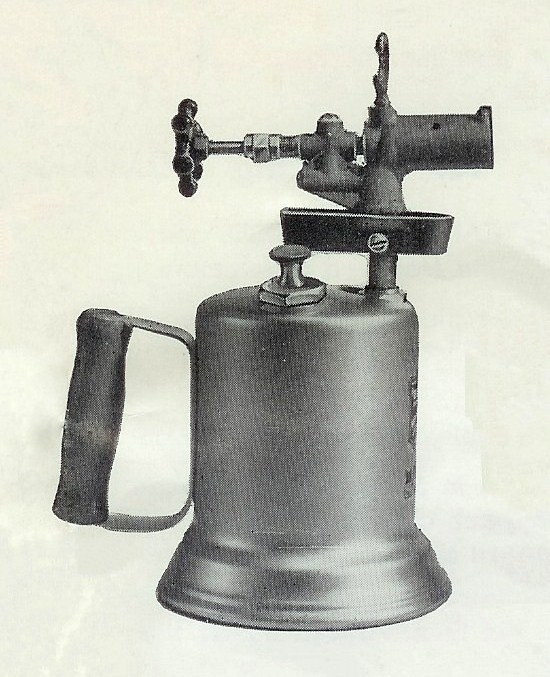 |
 |
 |
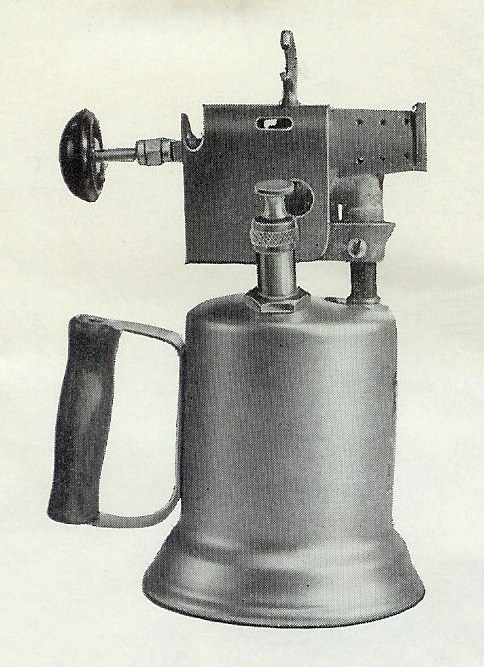 |
 |
|
Model 100 (quart
example)
|
Model 100A
(quart example)
|
Model 150
(quart example)
|
Model 200 (quart
example)
|
Model 200S (2 quart)
|
|
The
above examples illustrate the five models produced. The 200S apart, all
were available in either a pint or quart size. All were gasoline (petrol)
fuelled. Kerosene (paraffin) was an optional fuel on models 200 and 200S.
With one or two exceptions, most notably the handle brackets, these models
could have been produced at any point during the time that Butler
manufactured blow torches. Some variation
of details is discussed later. Some (if not all) of these models were
also produced for the other companies or distributors shown immediately
below. Butler Meaford is a possible exception as discussed
later.
|
|
The range of
models produced by Butler for themselves and for others |
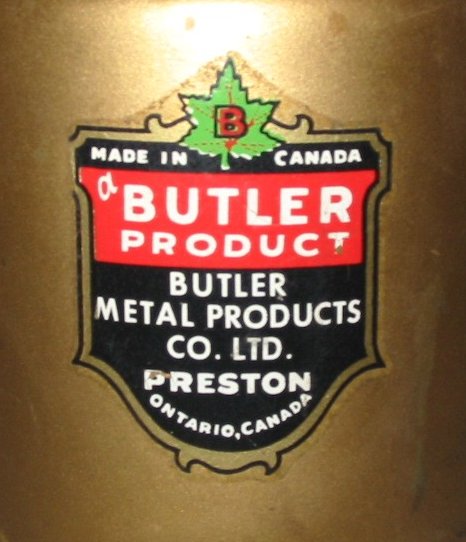 |
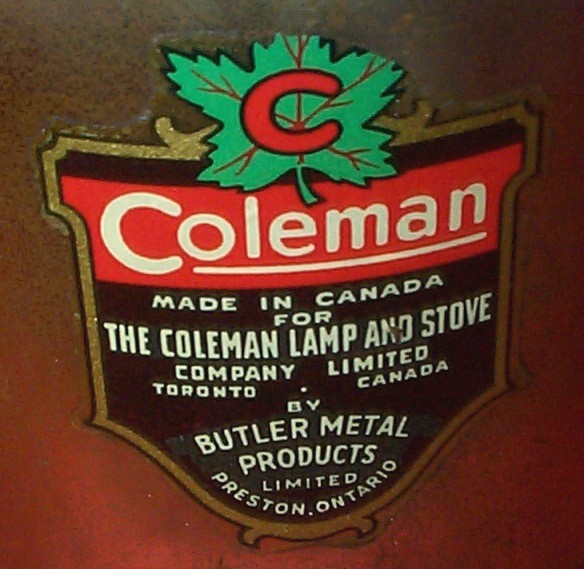 |
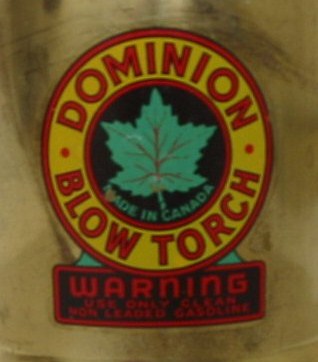 |
 |
 |
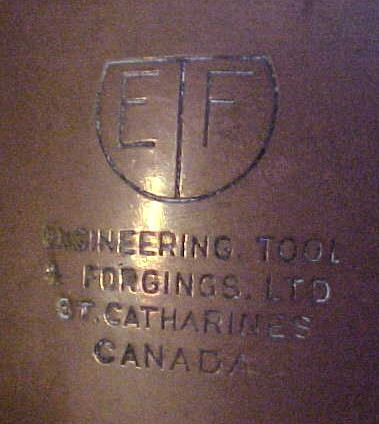 |
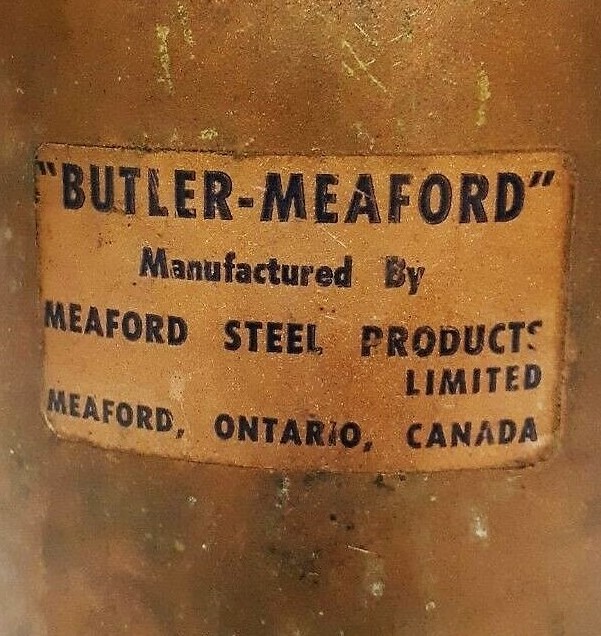 |
|
Butler
|
Coleman
(Canada)
|
Dominion
|
National
Tool
|
Teco (Eatons)
|
ETF |
Butler-Meaford
|
|
100
(quart)
|
92(quart)
|
500
(quart)
|
20
(quart) (see note 3)
|
|
100Q
(quart)
|
|
|
100
(pint)
|
|
501 (pint)
|
|
|
100P (pint)
|
241 (?) (see note
3)
|
|
100A
(quart)
|
102
(quart)
|
502
(quart)
|
|
52
(quart) (see note 3)
|
|
Equivalent known.
|
|
100A
(pint)
|
91
& 101 (pint)
|
503
(pint)
|
|
53
(pint) (see note 3)
|
|
|
|
150
(quart)
|
152
(quart)
|
504
(quart)
|
30
(quart) (see note 3)
|
|
125 / 150 (quart)
|
Equivalent known.
|
|
150
(pint)
|
151
(pint)
|
505
(pint)
|
|
|
|
Equivalent known.
|
|
200
(quart)
(k)
|
202
(quart)
|
506
(quart)
|
|
|
200 (quart)
|
|
|
|
204
(quart) (ke)
|
508
(quart) (ke)
|
|
|
|
|
|
200
(pint) (k)
|
201
(pint)
|
507
(pint)
|
|
|
|
|
|
|
203
(pint) (ke)
|
509
(pint) (ke)
|
|
|
|
|
|
200S
(2 quart) (k)
|
251
(2 quart)
|
|
|
|
|
|
|
|
252
(2 quart) (ke)
|
|
|
|
|
|
|
Notes:
1. All models were
gasoline (petrol) fuelled. Kerosene (paraffin) was an optional fuel on models denoted (k). Kerosene was the default fuel on models
denoted (ke).
2. Butler kerosene models
sold in Great Britain were suffixed with ‘K’, i.e. Model 200K (both
pint & quart). These
models may have had black painted handles. See below
3.
Model Numbers for National Tool and Teco are possibly incomplete.
4.
Model
Numbers for Butler-Meaford are at present a guess.
|
|
Apart from the Butler range listed above (first column), these are the known companies,
distributors or retailers for which Butler produced
blow torches, although it is not certain in each case exactly when, or to what
extent. This is discussed later.
We know for example that the relationship with
Coleman was over quite a long
period, and the Coleman Stove & Lamp Company, Toronto, was at one time listed as
export agents to Butler. It is also thought that Butler-Meaford did
not appear until the 1970s, and was possibly the outcome of some sort of transfer
or sale of the blow torch production side of Butler to Meaford
Steel.
|
|
William
Butler & William Herbert Butler: the William Butler Machine Co, Hamilton, Ontario |
|
Note.
This section has been revised in the light of new research. See Revisions to
Website. |
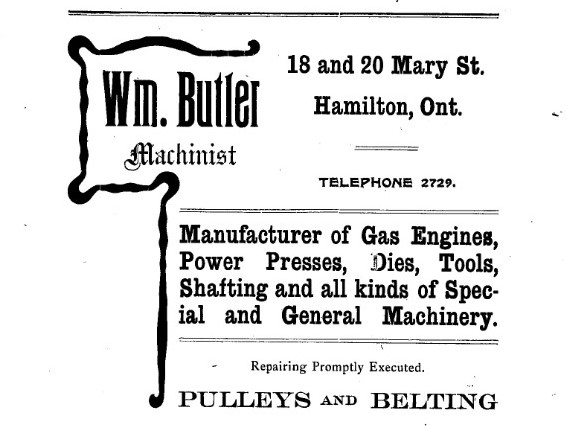 |
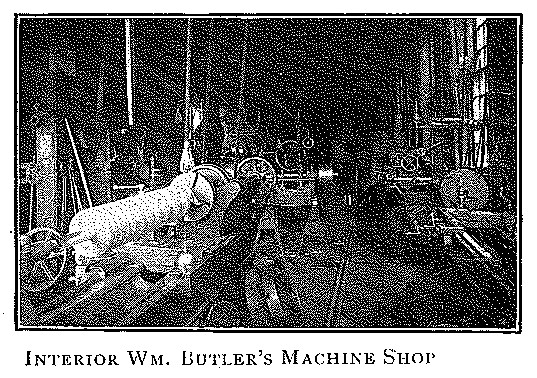 |
 |
|
Advertisement,
Vernon’s
City of Hamilton Directory, 1906.
Click
on to enlarge.
|
Articles
- Hamilton Herald, 1908, and Magazine of Industry and Daily Life, 1910.
Click on to enlarge.
|
Advertisement, Vernon’s
City of Hamilton Directory, 1933.
Click
on to enlarge.
|
|
Above are some examples
of advertisements, listings and articles for William Butler.
For those
interested, perhaps family historians, comprehensive listings for Hamilton
including
business / residential addresses, can be found in Irwin’s
/ Vernon’s
City of Hamilton Directories
between c1887 and 1956.
The Family Search
website also provides useful information about the Butler family. An account is
required to access, but it is free to use.
|
|
William Herbert Butler: Start of
Blow Torch manufacture, Preston, Ontario
|
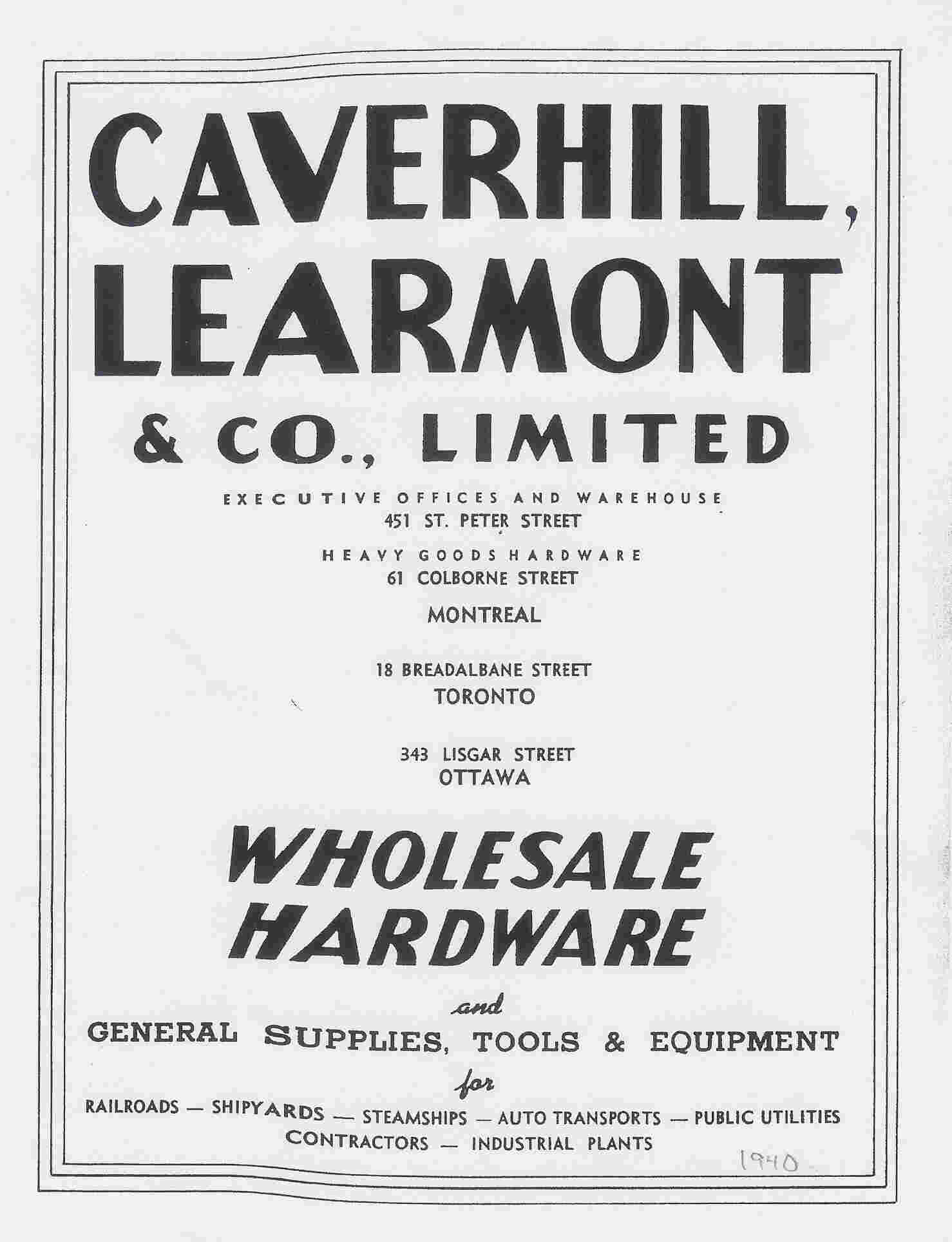
|
In
1938/39, William Herbert Butler relocated from Hamilton to Dolph Street
(formerly Guelph Street) in Preston, Ontario, where a number of
machine screw machines were acquired and Butler
Stampings & Machine Screws Limited was established.
By
1940 the Company
had begun the production of Blow Torches, although the extent to which blow torch
manufacture formed a part of the overall range of the business is not known.
Recent information regarding Engineering Tool & Forgings Ltd
suggests a start date for the production of blow torches of 1939. See Revisions to
Website.
The
first documented reference available for this period is an advertisement for
Butler blow torches, in the Caverhill,
Learmont & Co Limited hardware catalogue
of 1940 (left). Four models are listed, the 100, 100A, 150 and
200 (the two
quart sized 200S
is not listed at this point). Of note is that a very similar advertisement appears
in the same hardware catalogue of
1960, (see below the 1960s). Although the 1940 version is not
specific on the full range of models produced, it is probably safe to
assume that all models and sizes were in production, if not from the outset,
then at some point during the 1940s.
Detailed
descriptions, including listings of spare parts, can be seen by reference to the advertisements, but essentially the
models produced ranged from the lower priced 100 and 100A, both described
as suitable for household or intermittent use, to the medium priced mechanic's
torch, the model 150, and
finally the heavy duty mechanic's torch, the model 200. The 200S was
effectively a model 200 but with a two quart (half-gallon) capacity tank.
All
models ran on gasoline (petrol), whilst kerosene (paraffin) was an option on the
200 and 200S models. The gasoline / kerosene variation was determined by the type of
control valve needle and jet block that were fitted.
Note
that
the Butler style and design
of blow torch was typical of that of many of the US manufacturers at this time,
notably Clayton
& Lambert, Otto Bernz, Turner, and others.
|
|
Caverhill, Learmont
&
Co (1940). Click on to enlarge.
|
|
War
Years
|
|
During WWII Butler concentrated on war
orders for General Motors and produced stamped metal parts for army trucks and
other vehicles. The extent to which this affected the production of blow
torches and other manufactured items is unknown.
|
|
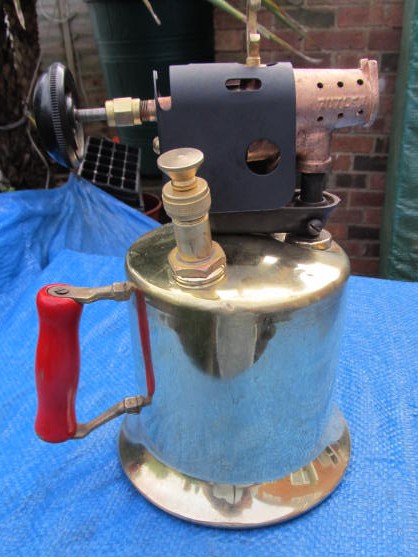
|
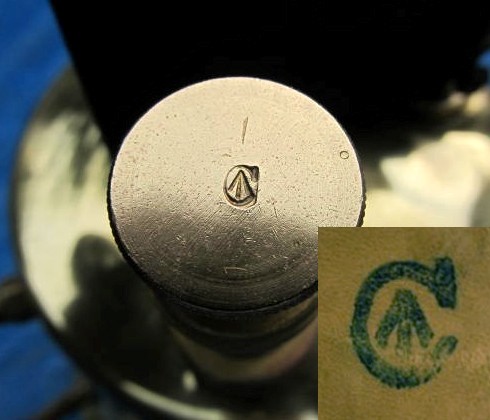 |
However, WWII
Canadian Munitions & Supply registries document blow torch purchases from
Butler throughout the war period, with the earliest noted being in 1941,
although a 1940 dated Royal Canadian Ordnance Corps packing slip lists a
Butler 100A torch.
Also
of note is that Canadian military purchases following
the end of WWII were virtually nil. The Canadian Government acceptance mark - a
broad arrow inside the letter 'C' (left) - which was exclusive to
Canada, would have
been present on military issue equipment, and is understood to have been seen on various blow
torches including Butler and Clayton & Lambert. The mark is said to have
been stamped in black ink on the brass surface (see inset to left) in some cases
on the
underside of the tank, rather than being permanently impressed into the
brass itself, and so could wear off quite easily.
However, Further information
(added April 2017, see Revisions to Website)
clearly shows the ordnance mark stamped into the pump knob of a fine
example of a Butler
200S.
|
|
Post War
/ 1950s
|
|
The
first post-war reference available is for a quarter page advertisement
from the Canadian Trade Index of 1946 (below far left) and is for the Butler Stampings &
Machine Screws Limited, located on Guelph Street (later Dolph
Street) in Preston, Ontario. They do work for the Coleman Lamp & Stove Company of
Toronto, which is the first link to be established with the well
known Coleman Company, although there is a possibility that Butler were
producing blow torches for Coleman as early as 1942 (see Coleman
Blow Torches, below).
The
1946 advertisement states "We Produce a Complete Line of Gasoline and Kerosene or
Paraffin Models to Meet All Requirements. In Pint, Quart or Two Quarts
Sizes". There is also reference in this advertisement to three agents
for the Company, J C Adams of Toronto, A C Gibb of Montreal, and Wm A Meyer
based in London, England. William A Meyer were at the time (or had been)
stockists / agents for Max Sievert and others.
A very similar advertisement
(below mid left) appears in the 1953, 1956, 1959 and 1960 editions of
the Canadian Trade Index. This version of the advertisement differs from
the 1946 version in that the name is now Butler Metal Products Limited,
and the Coleman Lamp & Stove Company of Toronto are listed as Export
Agents (in addition to the three aforementioned agents).
Note
that the same basic layout is used for both of these advertisements, including
the same illustration, despite small detail changes over this period (see Variations,
and dating of Blow Torch examples).
|
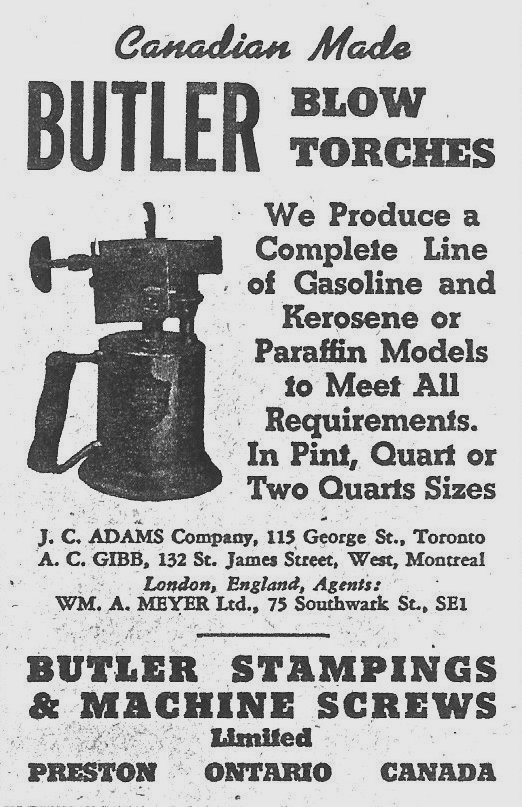
|
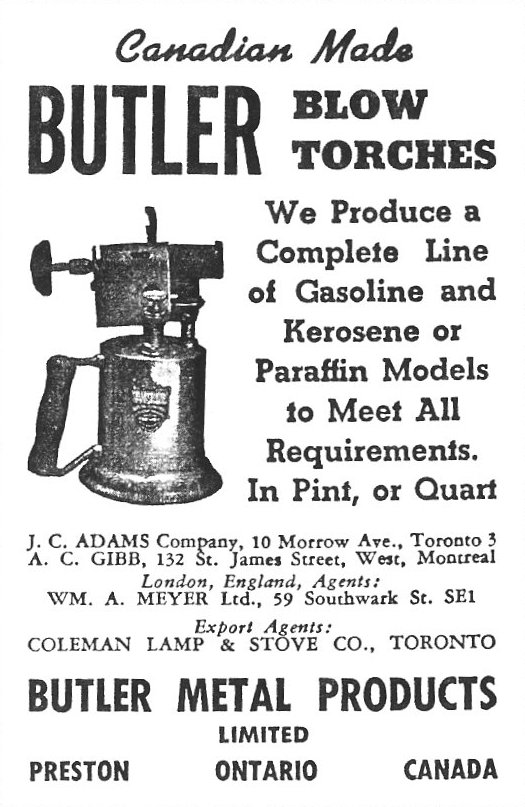
|
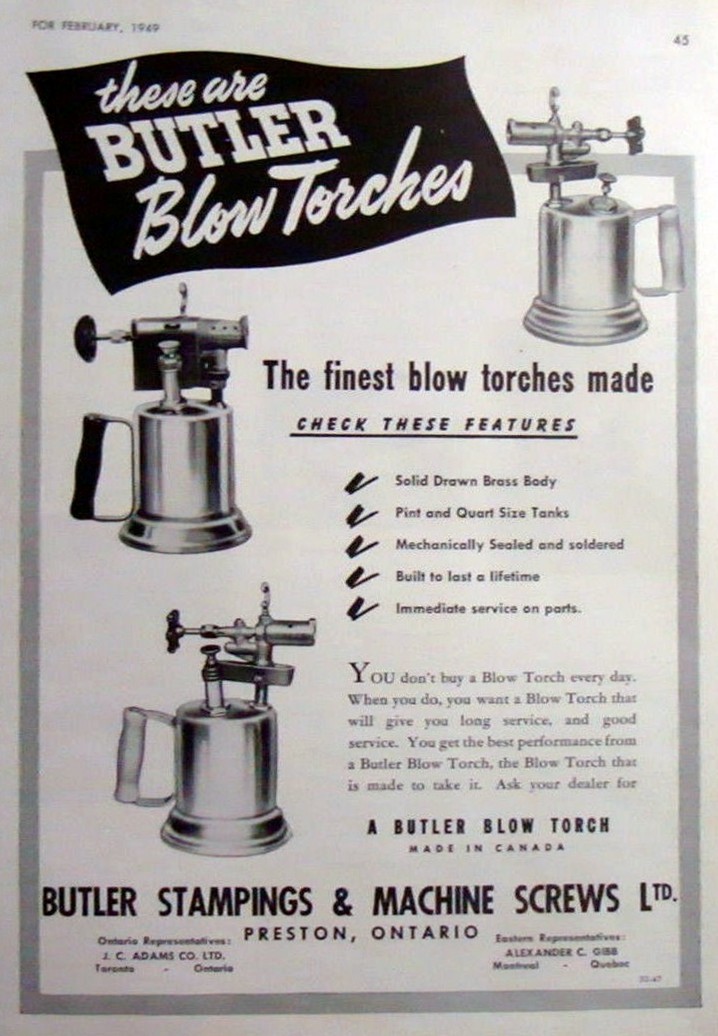
|
.jpg)
|
|
Canadian Trade Index (1946)
Click on to enlarge.
|
Canadian Trade Index (1953 /
56 / 59 / 60).
Click on to enlarge.
|
Butler Advert - February
1949
Click on to enlarge.
|
Butler Stampings &
Machine Screws Ltd photo
dated April 1948.
Click on to enlarge.
|
|
Information
added in April 2017 ( see Revisions to Website)
is the Butler advert (third from left) dated February 1949, which
gives the
Company name as
Butler Stampings & Machine Screws Limited
which puts the name change to Butler
Metal Products Limited at sometime between February 1949 and 1953.
The
photograph above right, (courtesy of the Region
of Waterloo Museums & Archives) is dated April 1948, with the Butler Stampings & Machine Screws Limited
name clearly seen above the entrance. (photograph added March 2023, see Revisions to Website).
There is the possibility that the actual date
of the name change was 1949 when one
source states that Butler was purchased by, or possibly, came under the
management of,
Mindustrial Corporation Limited. This is discussed further in 'the 1960s'
below.
|
|
A further reference for this period is an advertisement for the
four main Butler blow torch models – together with other makes of blow torch – in
the Wood
Alexander Ltd Industrial Catalogue No 50, of 1950 (below left). There are also two examples of a
Butler Metal Products Limited advertisement for three
models of Butler blow torch in the Hardware and Metal and Electrical
Dealer catalogue / magazine of 1953 (below centre). In both
examples, the two aforementioned Canadian agents, J C Adams & A C Gibb
are mentioned. Of note is that the model 150 is not shown in these two advertisements
even though there is nothing to suggest that production of this
particular model ceased any earlier - or later - than any of the other
models. Similarly, the two quart (200S) model is also not listed.
|
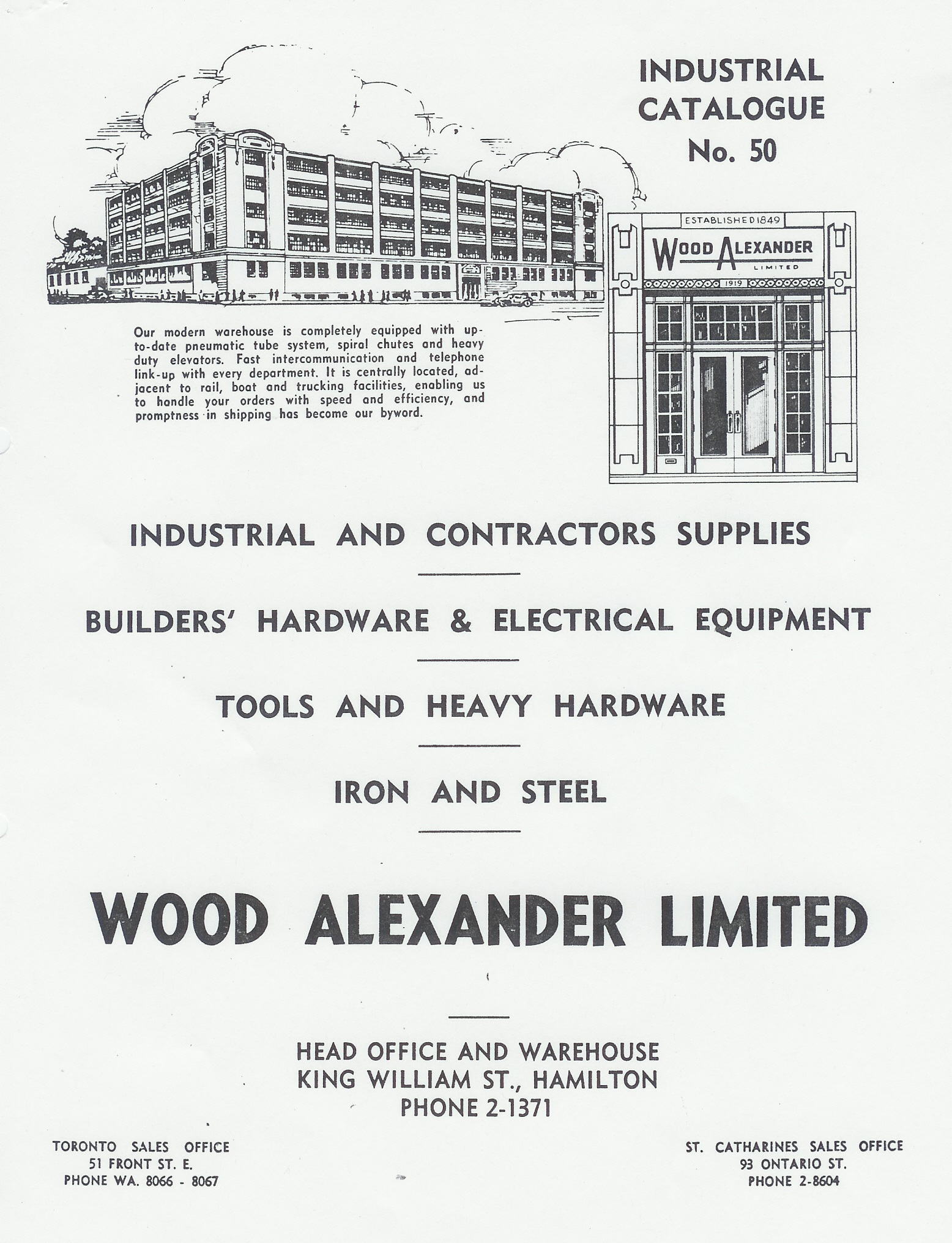 |
 |
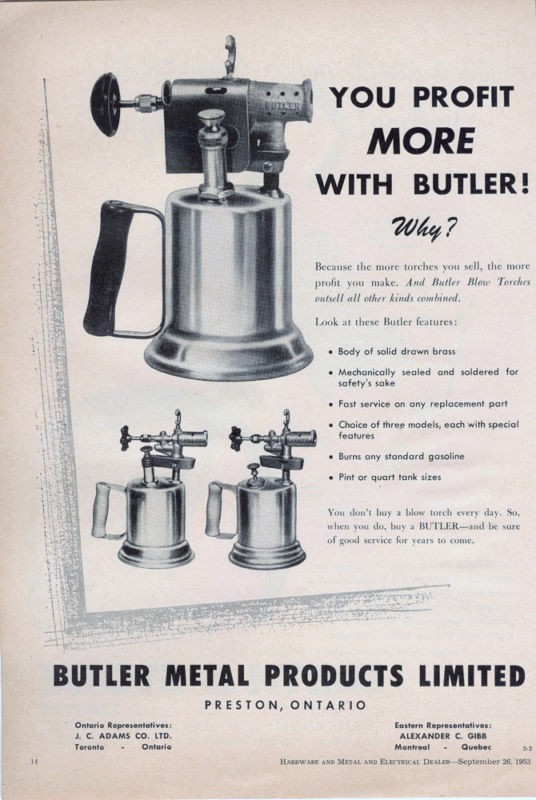 |
 |
|
Wood Alexander
Limited catalogue (1950).
Click
on to enlarge.
|
Hardware and Metal and Electrical Dealer
catalogue / magazine (1953).
Click
on a page to enlarge.
|
William A Meyer, London.
Leaflet from as
early as 1946? Click on to enlarge.
|
|
Finally
for this period is a leaflet, produced by
the aforementioned Wm. A Meyer of London
(above
right) for what is described as ‘The Butler Canadian Blow and Brazing Lamps’.
This could date from as early as 1946, when the Canadian Trade Index
advertisement for that year (above left) lists Meyer as agents for
the Company. Meyer appears - from this leaflet - to only have sold the two
models from the top of Butler's range, the 150 and the 200. Models 150 (pint) and 200 (quart) are the two petrol
types shown, whilst two
paraffin models are listed as 200 K (pint
and quart). It is possible that the suffix 'K' (which arguably could be said to indicate Kerosene) appears only to have been used
for this model when being sold or distributed in Britain by William A Meyer. See
further discussion below.
The reference in the Meyer advertisement to ‘blow lamps’
rather than ‘blow torches’ is interesting in that it probably
illustrates one of the distinctions between the two terms which are respectively used -
though not exclusively - on each side of the Atlantic even to this day.
The
William A Meyer reference is the only direct evidence available of the
sale of Butler blow torches anywhere other than
in Canada. Although Coleman (Toronto) were listed as export agents to
Butler, there is nothing known about Coleman's activities in this
respect. If Coleman did export blow torches it might be expected that they
were those produced by Butler, but with the Coleman
label, and that they would have been sold primarily in the United States. There is further
discussion on Coleman
later.
|
|
The 1960s
(and the Maxwell connection) |
|
Note.
This section has been revised in the light of new research. See Revisions to
Website. |
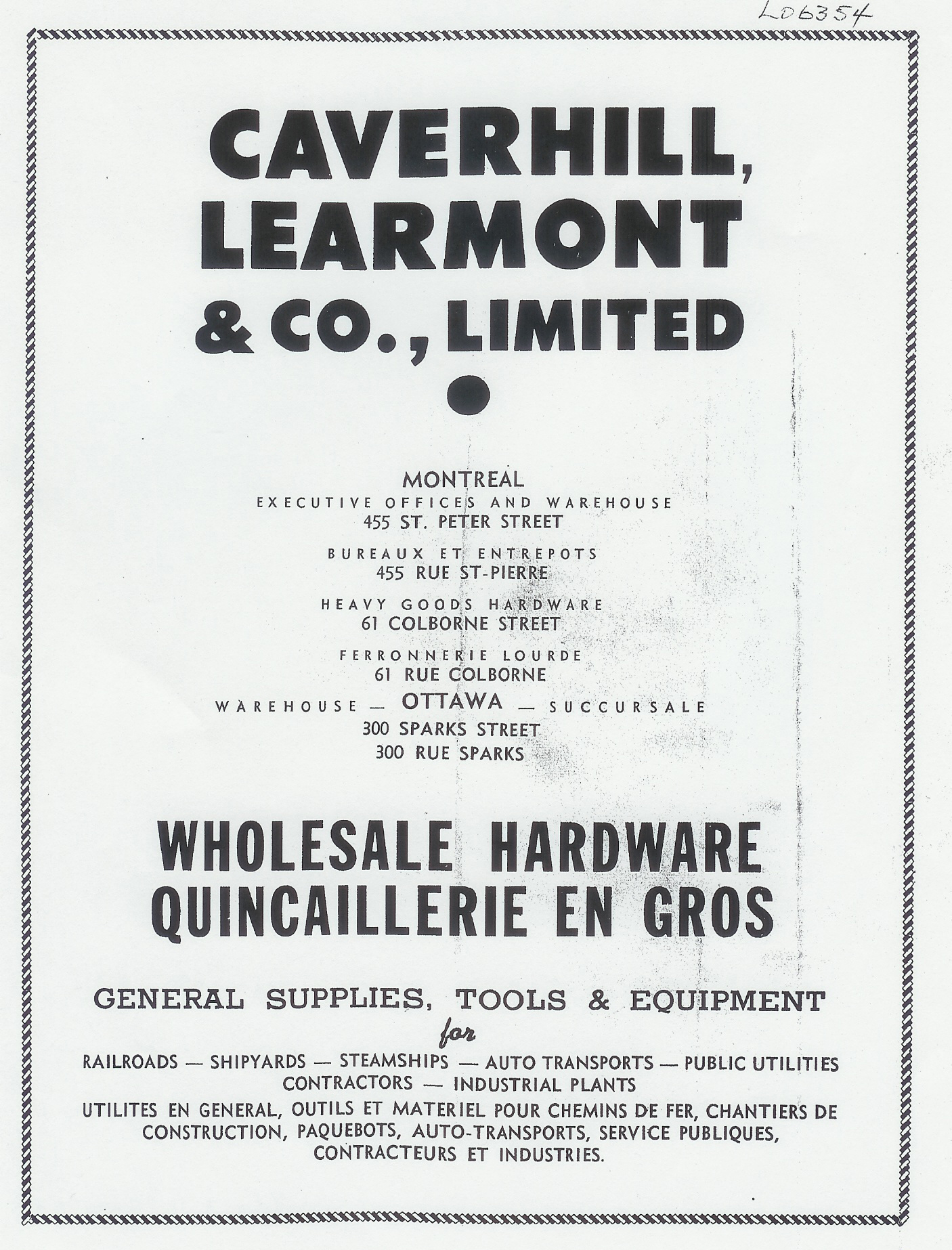
|
The
first reference to Butler for this period is another advertisement for the full range of Butler
blow torches within the Caverhill, Learmont & Co
Limited hardware catalogue of
1960 (left), written in both English and French. As discussed earlier, a very similar advertisement
appeared in the same hardware catalogue of 1940 (see
above: start of blow torch
manufacture). The two advertisements differ
slightly; most notably, the 1960 listing
refers to the two quart size
model (200S) which is not included in the 1940 listing. These differences aside, the 1960 version appears to be
largely based on the 1940 version, in terms of the descriptions, parts lists, and
illustrations used. Therefore, some caution should be exercised with regard to
the information given in the 1960 version as this may not reflect the actual details of manufacture,
components, or construction pertaining in 1960, for example, as suggested in
Variations,
and dating of Blow Torch examples, below.
Sources of information for this period
conflict to some extent, and there is very little known of
events as far as Butler is concerned. However, a brief description of Maxwell Limited,
listed as parent company to Butler in 1964, might help to fill in some
background.
Maxwell Limited was first established in Paris, Ontario in 1859. It was
owned and operated by the engineer Howard W Maxwell, and was a full
processing plant, including a foundry, blacksmith shop, machine shop etc.
The business later moved to St Mary's, Ontario in 1888, when the
company became known as David Maxwell & Sons, and employed at
one point over 100 people. Initially, the manufacture of farm equipment
was the core business, but this grew to include ringer washing machines,
lawn mowers, and included World War II munitions production, notably hand
grenades. Possibly as early as 1949, Maxwell Limited began to form
corporate alliances with other manufacturing companies under a holding
company called Hochelaga. Principles of the various companies were
principle officers of Hochelaga, and a subsidiary company,
Mindustrial Corporation, was set up to ‘sub-manage’ those companies
which included Butler Metals, Maxwell, Copp Clark Publishing,
Marchand Furnace,
Advanced Steel and possibly others. The executive from each company rotated
in levels of responsibility as each was a principle officer of the overall
Corporation. Maxwell purchased components during this period from other
Mindustrial companies, including Butler Metals. In particular, though not
exclusively, Butler were noted as supplying components to Maxwell for lawn
mowers.
|
|
Caverhill,
Learmont & Co ~ 1960
(click on for full
page).
|
|
A further reference is
the 1962 Canadian Trade Index listing of the Company as Butler Metals Limited. This is a notable change, in
that all previous available editions of the Trade Index from 1953 give the name as
Butler Metal Products Limited.
The 1964 edition of the
Canadian Trade Index notes the parent company of Butler Metals
Limited as Maxwell Limited, of James Street, St Marys, Ontario,
see the hand-written reference to Maxwell Ltd as "Parent
company of Butler Metals Ltd" on the
full page listing for
Maxwell Limited (below) and note also the name W
H Butler appears as President of Maxwell Ltd.
At
this time, William Herbert Butler was referred to by one source (St
Marys Museum) as W H (Bill) Butler, and that he had commuted
daily from Preston, or more precisely, from his farm near Galt, Ontario to
Maxwells at St Marys, Ontario. It has been suggested that these events of the 1960s were part of
attempts by
Maxwell to regain profitability. However, 1964 is the year that Maxwell Limited
closed, whilst Butler Metals (assumed
still under W H Butler?) continued in business in Preston, still
manufacturing components for the automotive industry, with blow torches, at
that time, still forming a part of their overall production.
|
 |
|
Canadian Trade Index
entry for Maxwell Limited ~ 1964 (click on for full page).
|
|
1970s: Final years of Blow Torch manufacture
|
|
The 1970 edition of the Canadian Trade Index lists the company as Butler
Metal Products Company Limited, and the parent company as Mindustrial
Corporation Limited, situated in Don Mills, Ontario, and listed as a holding
and management company for subsidiaries, so the Butler / Mindustrial
connection, possibly begun
in 1949, still
existed at this time.
Ownership changed hands again in 1972, when Guthrie Corporation of London
acquired the Company. Between 1971 to 1974, there are changes to the product listings within
the Canadian Trade Index, and although details of those listings are not
available,
perhaps of most relevance is that blow torches, as far as Butler are concerned, are no
longer mentioned in 1974. It is therefore
reasonable to assume that it was around 1973 that Butler ceased direct
involvement in blow torch production. As a result,
it could be suggested that Butler's blow torch side was either sold to, or merged with
Meaford Steel Products Limited (see immediately below), and it is in 1974 that a
link can be established between
Butler
Metal Products Company Limited and Meaford Steel Products Limited. See
the Canadian Trade Index entry for Meaford Steel, in 1974,
below. Possibly Meaford Steel simply acquired the
tools and machinery for blow torch
manufacture from Butlers, and incorporated the name Butler, as it
was a well known brand.
That said, one possible reason for the end of
Butler's direct involvement in blow torch manufacture is that by the 1970s the type of gasoline (and kerosene) blow torch which
Butler produced was beginning to be replaced by the newer and
lighter propane type torches - typified by Bernzomatic (Otto Bernz) - which were
arguably considered easier and less hazardous to use. Another possible reason
was the acquisition of the Company by Guthrie, whereby more emphasis was placed
on the production of automotive components. Guthrie
Corporation's activities were structured under a
number of various operating divisions, automotive components being just one.
This division consisted principally of Butler Metals, already a major supplier
to General Motors, and Butler Polymet, who primarily manufactured and assembled
plastic mouldings. Butler Polymet were a Delaware Corporation with operations in
Canada, and were later acquired from Guthrie in 1978 by Rockwell International
Corporation. The two Butler names (Butler Metals and Butler Polymet) are not, as
far as can be found, connected in any other way.
As
a footnote to Mindustrial Corporation Limited, one source states that they merged with Guthrie Canadian Investments Limited
in 1978, to continue as Guthrie
Canadian Investments Limited.
|
 |
|
Canadian Trade Index entry for Meaford Steel Products ~ 1974.
(click on for full page). |
|
1970s: Meaford Steel Products Limited
|
The
earliest reference is to the Meaford Wheelbarrow Company located on Marshall Street,
Meaford in 1905. After 1920 it was known as Meaford Steel
Company Products. The hardware side of the
business continued until it was sold to Walker and Erskine in 1938. Walker and Erskine
ran a hardware store in Meaford.
Again, with reference to the Canadian Trade Index (partial) series, of the
Canada Science and Technology Museum it is known that from 1930 to 1974 the Company
was located in Meaford and produced wheelbarrows, road scrapers and concrete
carts. The 1972 and 1973 editions are not in the museum’s series, but the 1974
edition includes the entry for Butler-Meaford blow torches (above).
There is a further gap in the museum’s series of the Canadian Trade Index, then in the 1977 edition and
all others until 1985, there are no further references to blow torches.
It therefore follows that Butler-Meaford blow torch production ceased
at some point between 1974 and 1977.
One
account is that Meaford Steel closed in Meaford about 1989(?), at which time they were making
wheelbarrows. Another account is that the Company continued in Bloomfield, Ontario,
although there is reference in September 1996, to the acquisition of the
Wheelbarrow Division of Meaford Steel Products by the
True Temper Hardware Company, Camp Hill, Pennsylvania.
|
 |
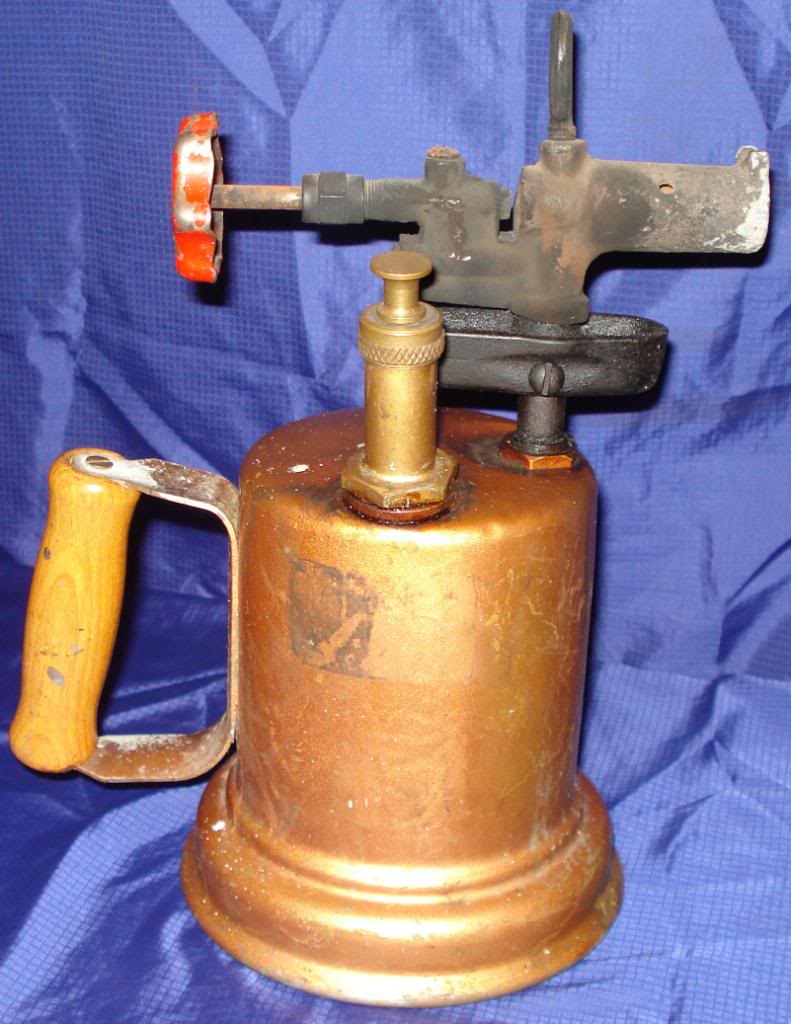 |
 |
 |
|
Butler-Meaford
(Butler No 100A equivalent)
|
Butler- Meaford
(Butler No 100A equivalent)
|
Butler-Meaford
(Butler No 150 equivalent) |
|
Butler-Meaford blow torches. Was this the outcome of the acquisition of the Butler side of blow torch
production by Meaford Steel? Note the
somewhat basic labels on these torches. See
close-up of label.
|
|
Post Blow Torch history
|
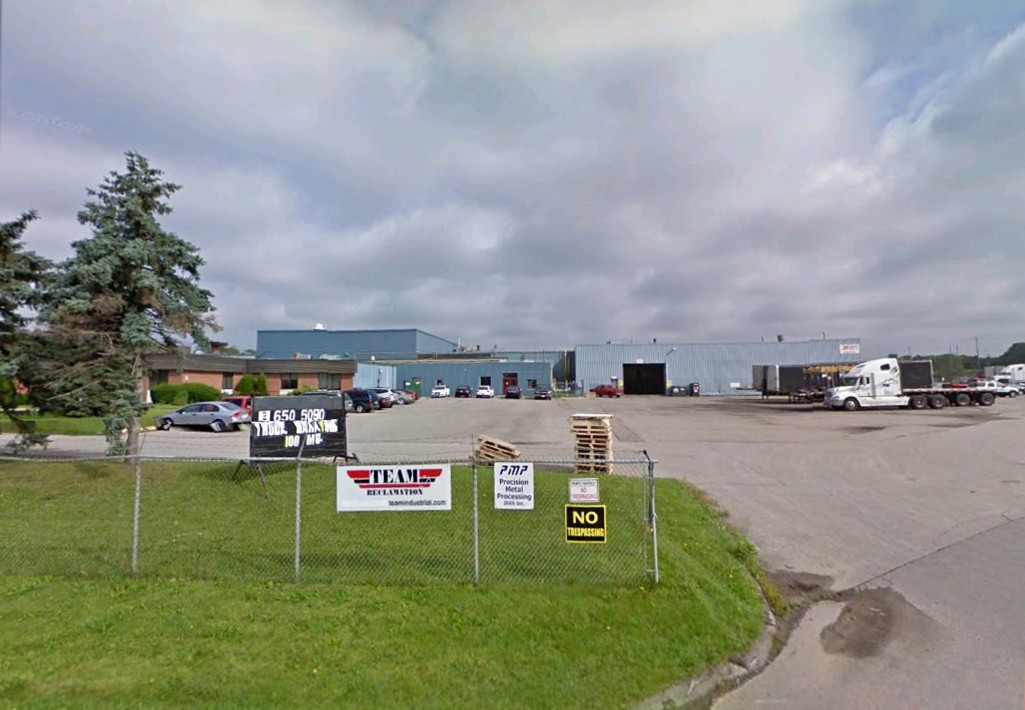
|
By
the early 1980s Butler was a leading manufacturer and assembler of
stamped metal products, especially for the auto industry, but they also produced parts for the compressor,
appliance and similar industries. Accounts conflict, but in 1989 the Company
was said to have been sold for $34 million to five senior plant managers and a Quebec
equity corporation. Also at this time, Butler's parent company was said
to be BMG Canada, with whom Butler shared premises in Cambridge, Ontario.
In 1996 the Company was sold to
Oxford Investment Group Inc. a buyout firm looking to build a new
automotive stamping group. The firm bought Butler for an undisclosed amount and
helped it win a major contract with General Motors Corporation.
Within a few years Oxford added two other stamping suppliers - Lobdell Emery
Corporation
and Howell Industries - creating Oxford Automotive Inc. which was run from a
new headquarters in Troy, Michigan.
In 1997, Butler Metal
Products won a Cambridge Heritage Business Award, based on both the length of
time it had been in operation, and the length of time it had operated in
Cambridge (Preston). The city of Cambridge was formed in 1973 when the city of
Galt merged with the towns of Preston and Hespeler and parts of the townships
of Waterloo and North Dumfries. See:
https://www.cambridge.ca/en/index.aspx
Oxford
Automotive closed The Company in September 2002 - due to what was claimed to be a continuing decline in
business - with the loss of
some 200 jobs. At one time, it is said, the Company employed 450 workers.
|
|
The
last site of Butler? ~ 1574 Eagle Street North, Cambridge
|
|
Markings
and decals used by Butler |
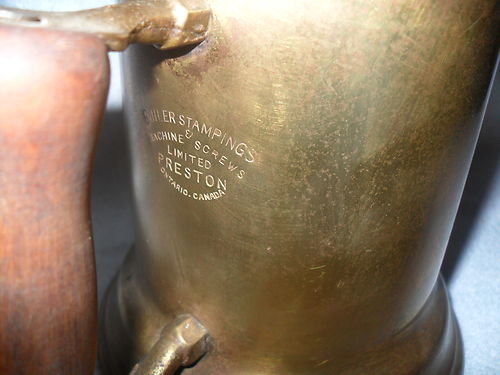 |
.jpg) |
%20to%201962%20(query).jpg) |
%20to%201970%20(query).jpg) |
%20to%201972%20(query).jpg) |
|
Name
stamped into tank, BUTLER STAMPINGS & MACHINE SCREWS
LIMITED, PRESTON, ONTARIO, CANADA. This only appeared during the early
period 1940 to 1949(?), possibly on all models, when the two-piece (cast brass) handle bracket assembly
was used. (See variations
below).
|
Decal:
1940 to c1949
Butler Stampings
& Machine Screws Limited
|
Decal: c1949 to 1962
Butler Metal Products
Limited
|
Decal: 1962 to 1970
Butler Metals Limited
|
Decal: 1970 to 1973(?)
Butler Metal Products
Company Limited
|
|
Markings
and decals
used by Butler. Note that some of the dates given are subject to verification
|
|
Variations,
and dating of Blow Torch examples |
|
As mentioned in the
introduction, at first glance, a Butler blow torch (or one supplied to others)
could have been produced at any time during the period that Butler
produced blow torches. If a readable decal still exists (and this applies
to Coleman also) this is the best indication of the approximate date of
manufacture. See decals used by Butler, and
decals used by Coleman. Apart
from this (or where no decal exists), and bearing in mind the limited
number of examples to be seen, and possible anomalies such as the
replacement of non-original parts, it is possible to make some generalisations
with regard to the type of handle bracket(s), the colour of the handle
itself, and some other detail differences.
Two
types of handle bracket(s) were used. The
early (say 1940s) type was a two-piece bracket assembly, probably
supplied throughout the Butler Stampings & Machine Screws Limited period.
This comprised two separate (and differing) cast brass brackets, screwed
into inserts fitted within the tank side. Each set of brackets differed
depending on whether it was for the pint or the quart / two quart size
tank. In addition, the two-piece bracket assembly was only used on
models sold with the Butler name, although there is one exception
to this, see Engineering Tool
& Forgings Limited (ETF).
The
other type of
handle bracket used subsequently (though possibly fitted to the model 100
from the outset, as it is shown in the 1940 Caverhill,
Learmont & Co Limited hardware catalogue
of 1940) was a one-piece
pressed brass type, soldered to the tank. It appears that
only the one size of this type of bracket was ever produced, regardless
of tank size. Both types of handle bracket(s) are shown below. Also see Collection:
past and present.
With regard to handle
colours, it appears that all Butler blow
torch models, including all other Butler produced blow torches, be they
for Coleman, Dominion, ETF, National Tool, Teco, or Butler-Meaford, were
fitted with the clear varnished handle. The two exceptions to this are the red
painted handle which appears only to have been used on early models
(the 1940s) and only those sold with the Butler name,
and where the earlier two-bracket
handle arrangement was fitted. The other exception is the black painted handle,
which interestingly only seems to appear on the Butler 200K (kerosene)
models, sold in Great Britain by the agents William A Meyer of London. The
use of the earlier two-piece handle bracket assembly, with black handles, indicates their use early in
Butler’s production (1940s) and confirms William A Meyers' early involvement.
The only other notable variant is the control knob on
the models 100 and 100A.
It appears that the six-lobe cast (iron?) knob was fitted to
early models of the 1940s. Thereafter, the six-sided pressed steel knob
seems to have been the norm. Both types are shown below right.
Models 150, 200 and 200S were always fitted with the black plastic (or
bakelite) domed shape control knob, as is seen on any of the examples of
these three models on
this site. See Collection: past
and present for example. Other slight differences can be seen, including two variants of
the 200 / 200K burner, and variations in the windshields to the models 150 and 200 (the
100 & 100A were never fitted with windshields). |
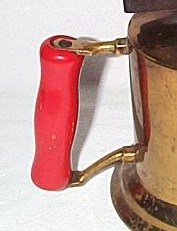 |
 |
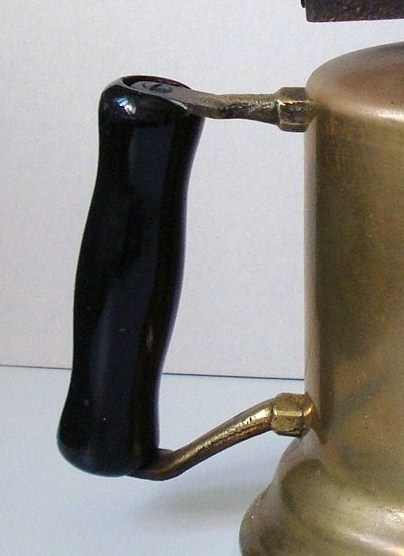 |
 |
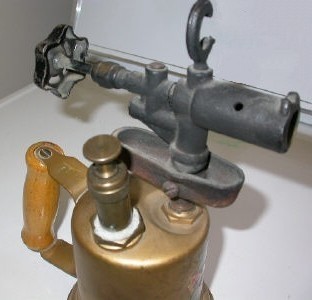 |
|
Early
two-piece (cast brass) handle bracket assembly, and red painted handle
|
Later one
piece (pressed brass) handle bracket, and clear varnished handle (See revisions)
|
Early
two-piece (cast brass) handle bracket assembly, and black painted handle
|
Butler
100 and 100A burner assemblies. Left, the six-lobe cast (iron?) control
knob, fitted to early models (1940s) possibly during the time the Company
was Butler Stampings & Machine Screws Limited. Thereafter, the
six-sided pressed steel knob - right - seems to have been the norm |
|
Butler
blow torch tank: materials of construction, and finishes.
|
|
Information
has come to light (see Revisions to Website)
regarding the construction of the tank of a Butler blow torch, or rather
the materials used in its construction. The documented information on this
particular aspect of construction can be seen,
for example, in the Caverhill,
Learmont & Co hardware catalogue
of 1940 which describes the tanks thus: "All models are constructed with
solid drawn, highly polished brass bodies (tanks). Models 100 and 100A have terne
plate bottoms while models 150 and 200 have brass bottoms".
(Generally speaking, terne
plate is a mild steel plate coated with an alloy of lead containing tin
and antimony). However, a model 100A (see right) has come to light, which has an
all steel tank, as the vial containing small magnets demonstrates. In
the absence of mention of
an all steel tank in any of the available advertisements / literature, the
best assumption is that "all steel" tanks were a war time product, in order
to save on the copper / brass required for components for the war effort. And
if the
move to an all steel tank was just a temporary war time measure, it would
be reasonable to assume that advertising the fact was not high on Butlers'
list of priorities whilst in the midst of orders for war related products. However,
if it is the case that the "all steel" tank was just a wartime
departure, it is not known whether such examples were produced in the post-war
years. It has been suggested that there could have been a move in the
later period of Butlers' production towards a lower cost product, and
indeed, a number of the main US blow torch manufacturers, in later years, switched to
"all steel" tanks for some of their models, though this in
itself is not to say that Butlers did so.
Self-evidently,
a paint finish was applied to the "all steel" tank. Apart from
protecting the steel surface, the tank then had the appearance of being
brass. That is not to suggest that the paint finish was an
attempt to disguise the steel surface, more likely, it could be suggested,
a matter of producing uniformity of appearance across the range. That said, many examples of Butler produced blow torches had a paint
finish to the tank, even when of brass construction. Quite what the
purpose was is open to speculation, but it might be suggested that a paint
finish (presumably including some form of primer) to the (unpolished) brass surface was a
cheaper(?) alternative to a final
buffing operation to the brass in order to achieve a high shine, which would then have had
to have the
addition of a clear lacquer finish. This variation in finishes to the
tank, be it paint or lacquer (which included the handle bracket(s), though not the
pump or any of the burner assembly) is
readily observable on examples found today, but the extent to which
one finish was used rather than another cannot be described or quantified
in any detail. |
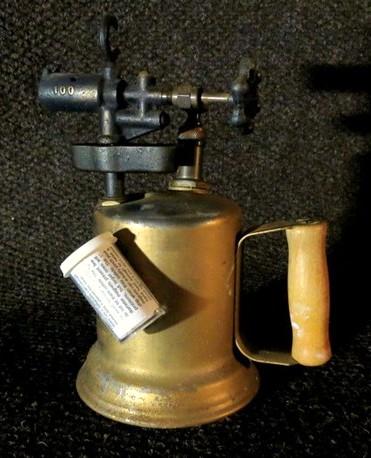 |
 |
|
A note
about part numbers
|
|
The
owners of a Butler 150 (in Canada) made contact and attached some photos. Of
particular interest is that one photo depicted the number
445 (far left), imprinted or formed on the inside bottom face of the cast iron priming cup.
|
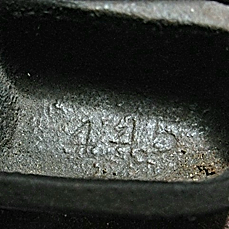
|
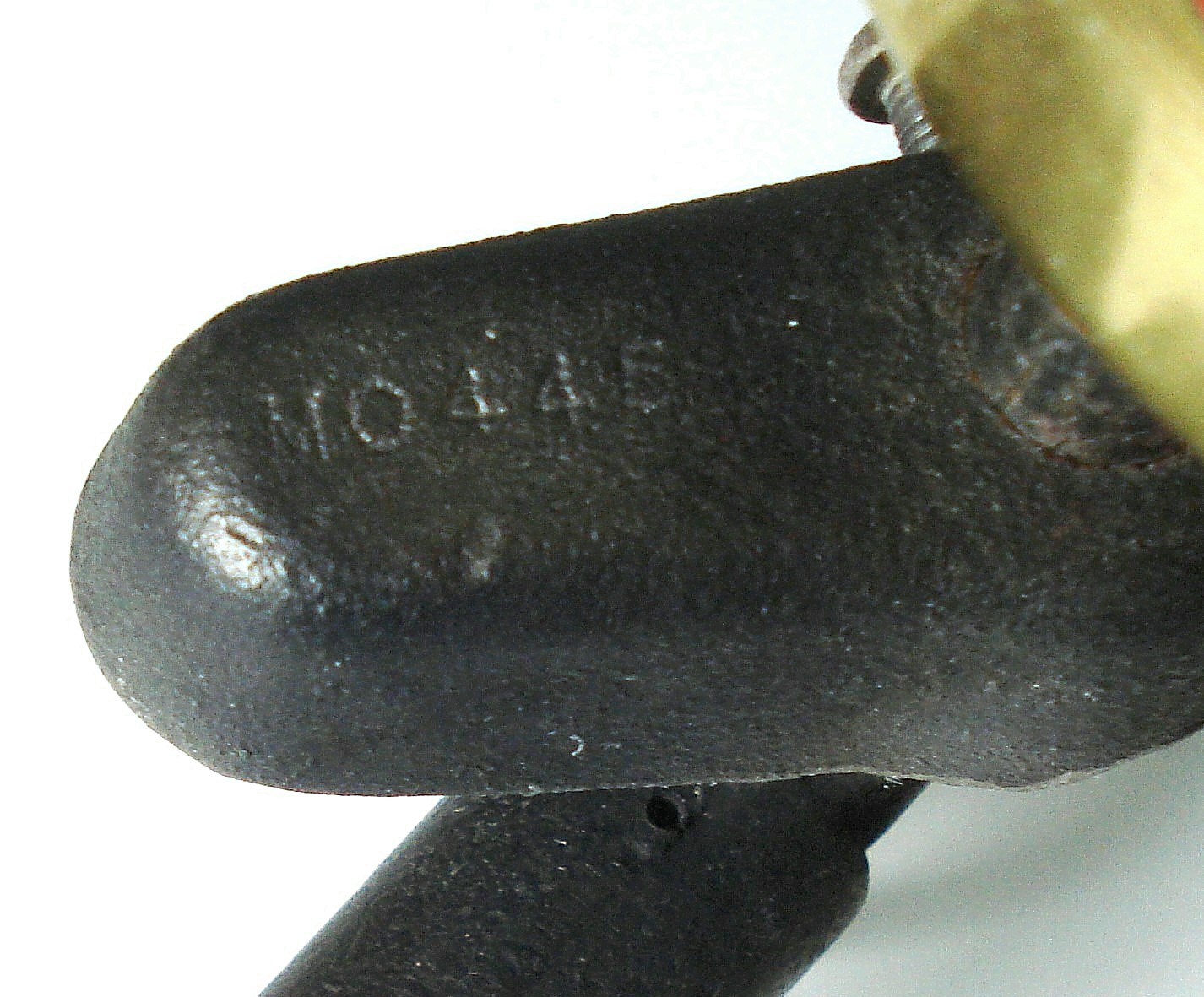
|
This same part number, but prefixed
"MO" (or "M0") can be seen on an example of a Dominion
504 (near
left), but this time the mark is on the outside face of the priming
cup. These part numbers appear to be on some, but by no means all, of the priming cups
for the three
models 100, 100A and 150.
On checking
with the parts list of the Caverhill,
Learmont & Co Limited hardware catalogue
of 1940 part number 455 (yes, 455) is for the "priming cup and screw" for
models 100, 100A and 150. This same number (455) but with a separate part
number for the fixing screw (186), can be seen on the parts lists for both
Coleman and Dominion
blow torches.
The
discrepancy between the numbers "455" and "445" cannot
be explained.
A
different shape of priming cup was produced for models 200 / 200A (and the
Coleman & Dominion etc equivalents) and given part
number 255, but this number (if it appears at all) has not been seen on an
example.
Although
the number of Butler blow torch examples available for inspection is very
small, it is probable that no other components were actually marked with
their respective part numbers.
|
|
Butler 150. Priming cup,
Part No 445
|
Dominion 504.
Priming cup, Part No 445
|
|
Model number markings |
 |
 |
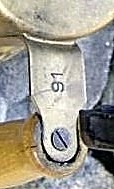 |
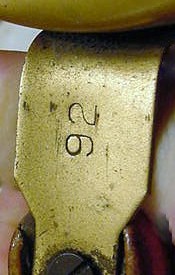 |
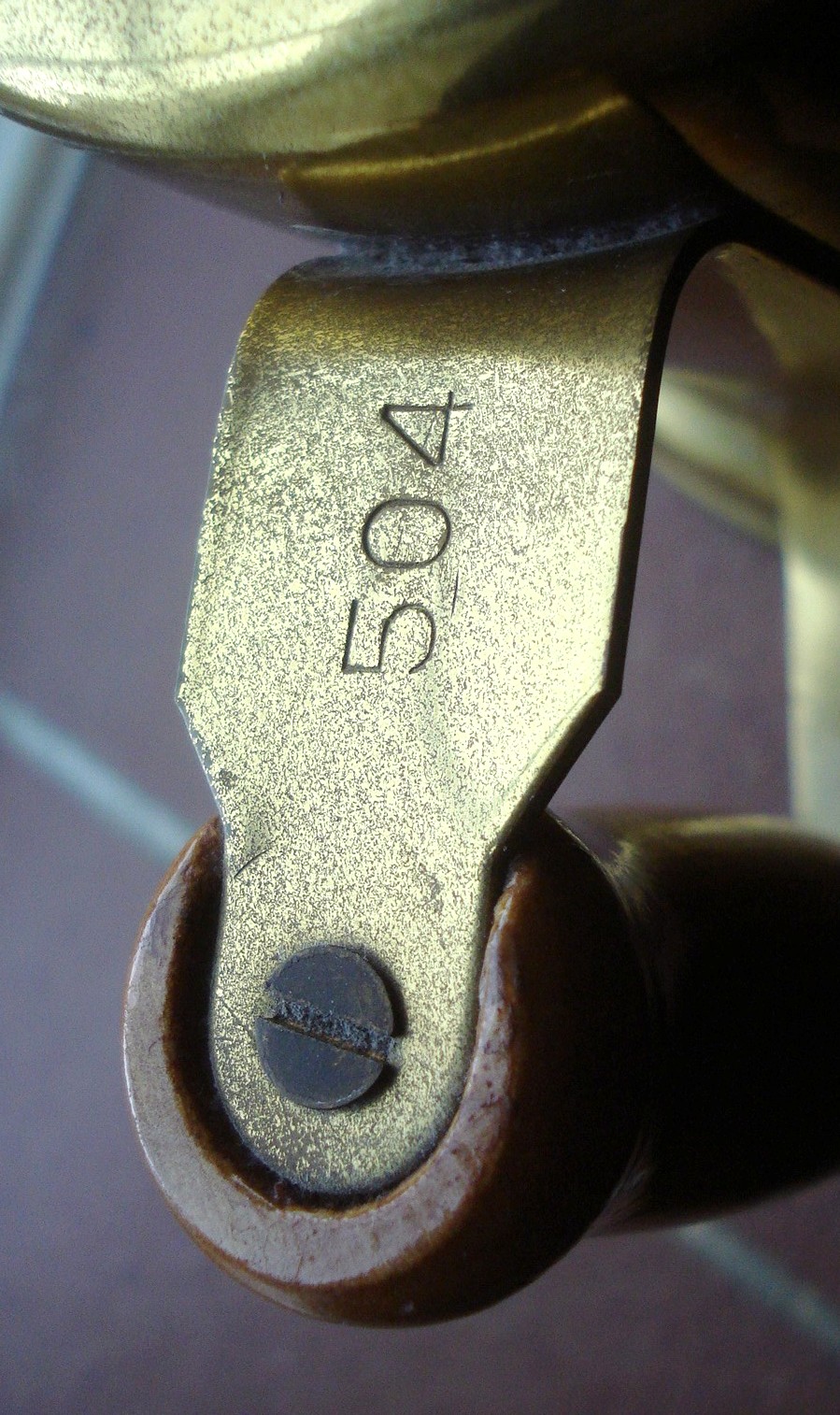 |
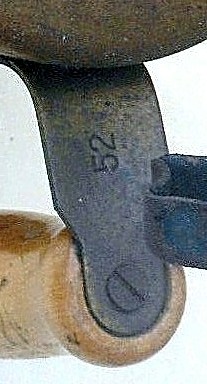 |
|
Butler
100
|
Butler
100A
|
Coleman
91
|
Coleman 92
|
Dominion
504
|
Teco 52
|
|
Wherever
the one-piece
pressed brass type handle was fitted (see above)
generally the model number was stamped into the top surface. It is
possible that model numbers were also stamped into the handles of National Tool
& Butler-Meaford models, but examples are not available to confirm
this.
In the case of
ETF (Engineering Tool & Forgings) the one-piece
pressed brass handle was believed never to have been used, and although
the name "Engineering Tool & Forgings...etc" is clearly
pressed into the tank, model numbers per se would not have been
marked on the ETF range of blow torches. This would also have applied to
those models of Butler blow torches where
the two cast-brass bracket
handle arrangement was fitted (see above).
|
|
Markings seen on the
burner of Butler produced blowtorches, and confusion over the "200
K" mark. |
|
Observation
of the burner on any Butler produced blow torch, be it for Butler
themselves, or for the known companies or distributors for which Butler produced
blow torches (see list above)
will show (though several burners are without any markings) the name
"Butler", and / or the numbers "100", "150",
or "200 K". This broadly differentiated the four models
produced, the 100, 100A, 150 and 200 / 200S, see above.
However,
there is some confusion over the "200 K" marking, which is often
incorrectly stated as being the model number of 200 / 200S examples seen
for sale, in particular, on internet auction sites. However, model number
200 K is possibly correct for those models considered to have been
produced for export, and probably with a black handle, notably for
sale in Great Britain by William A Meyer (and possibly other export
areas). See variations, and dating of blow torch examples above,
and also the related William
A Meyer leaflet. Reference to the Meyer leaflet further
confuses when it is seen that the two models listed as being for paraffin
are given the number "200 K", whilst model "200" is
the number given for the quart size petrol example. The particular Meyer
numbering may well have been devised solely by / for William A Meyer; we
do not know.
Note
that there is clearly no definitive explanation for
these apparent variations due to the very small sample of actual models
available for inspection.
|
|
Packaging and
Instructions |
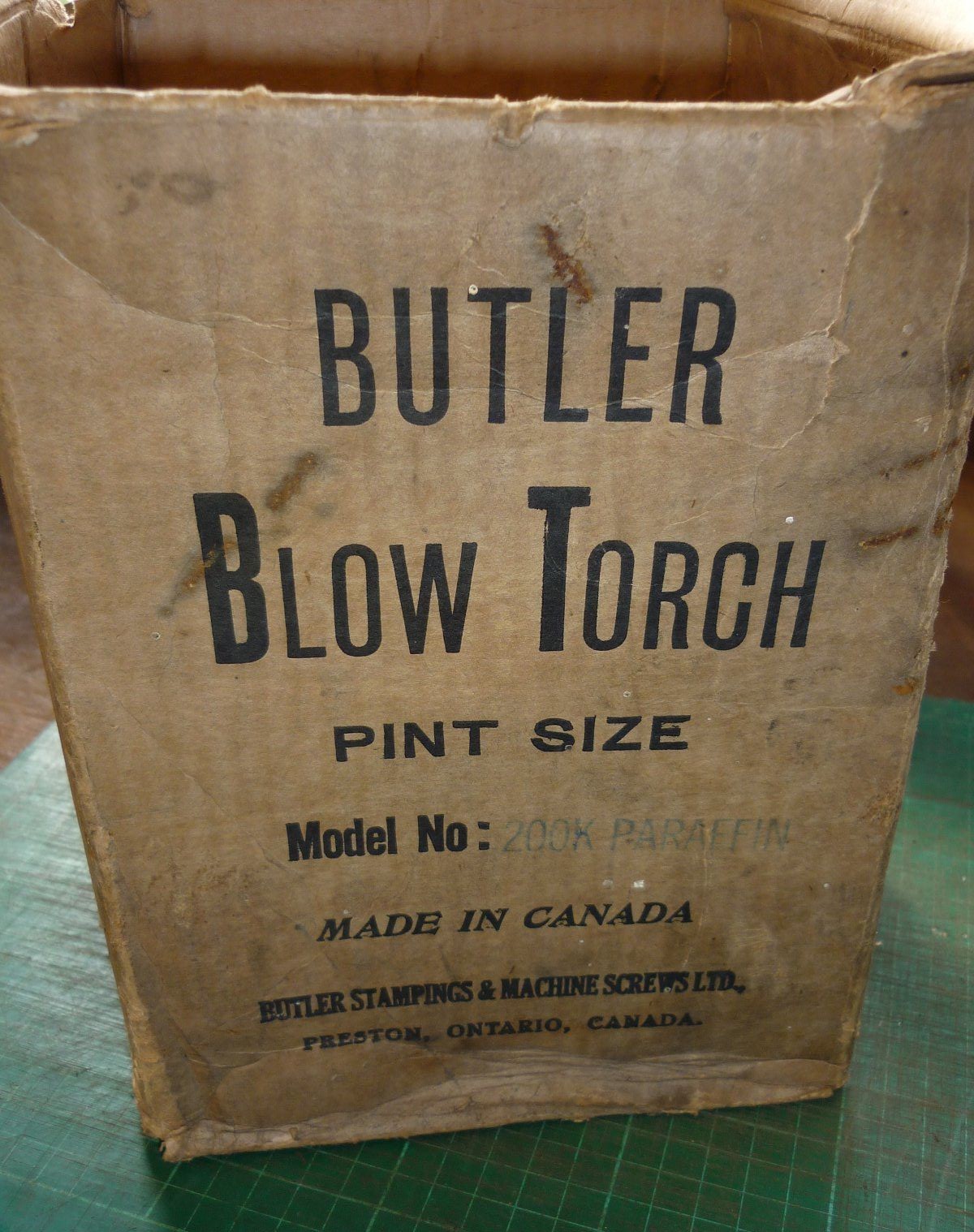 |
 |
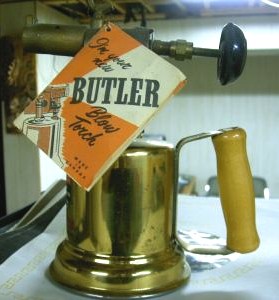 |
 |
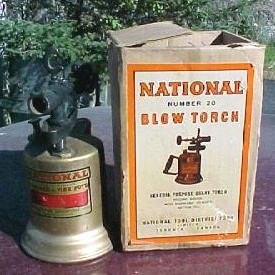 |
|
Box
and instructions for Butler 200K (paraffin). See "200
K" mark, directly above.
|
Butler 150
with detachable label
|
Coleman 102 with
box and instructions
|
National No
20 with box
|
|
Very
little in the way of packaging or instructions is found for Butler related
blow torches. Above are some examples. Click on a photograph to enarge.
|
|
Chronology
- Summary of approximate dates and arrangement of Butler as a business
concern
|
|
c1887
William Butler listed as machinist in Hamilton, Ontario
1930
The William Butler Machine Company, Ontario, established.
1938
William Herbert Butler relocates to Preston, Ontario and establishes the Butler Stampings & Machine Screws Limited.
1940
The Company
begins the production of Blow Torches. (1939 suggested. See Revisions
to Website).
1946 Butler Stampings & Machine Screws Limited
listed in Canadian
Trade Index, and located at Guelph Street, Preston.
1949? The Company comes under the management of Mindustrial Corporation
Ltd. The Company name changed to
Butler Metal
Products Limited at this time?
1953
The Canadian Trade Index lists the company as Butler Metal Products Limited,
and advertisement appears in the 'Hardware and Metal' catalogue with the same name.
1962
The Company becomes (and the Canadian Trade Index lists the company as) Butler Metals Limited.
1964
The Canadian Trade Index lists the Parent company of Butler Metals Limited
as Maxwell Limited. W H (Bill) Butler listed as President of
Maxwell Limited.
Maxwell Limited close.
1970
Canadian Trade Index listing is for Butler Metal Products Company Limited.
Mindustrial
Corporation is still listed as management
Company.
1972
The Company acquired by Guthrie Corporation of London.
1974
Blow torches no longer mentioned in the listing for Butler in Canadian Trade
Index. Blow torch
production sold / transferred to Meaford Steel? Butler-Meaford blow torches produced?
1974 - 1977? Butler-Meaford blow torches
produced, and production ended, sometime during this period.
1980s
Butler
listed as a leading manufacturer and assembler of
stamped metal products.
1989
The Company said to have been purchased by a group of five senior plant managers and
a Quebec equity corporation. BMG Canada said to be parent company of Butler.
1996
The Company was sold to
Oxford Investment Group Inc. (later Oxford Automotive Group Inc).
1997
Butler Metal Products Company Limited received Cambridge Heritage Business Award for being in
business for over 100 years, and having a continuous connection with Cambridge
for over 40 years.
2002
(Sept) The Company closed. Butler Metal Products
Company Limited was at this time listed as being at 1574 Eagle
Street North, Cambridge, Ontario, N3H 4S5.
|
|
Butler
Blow Torches produced
for, or distributed by, others
|
|
Coleman Blow Torches
|
 |
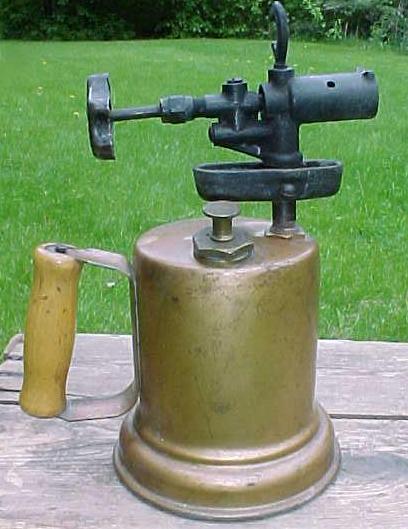 |
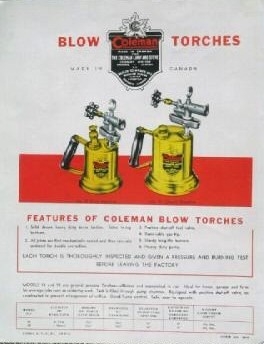 |
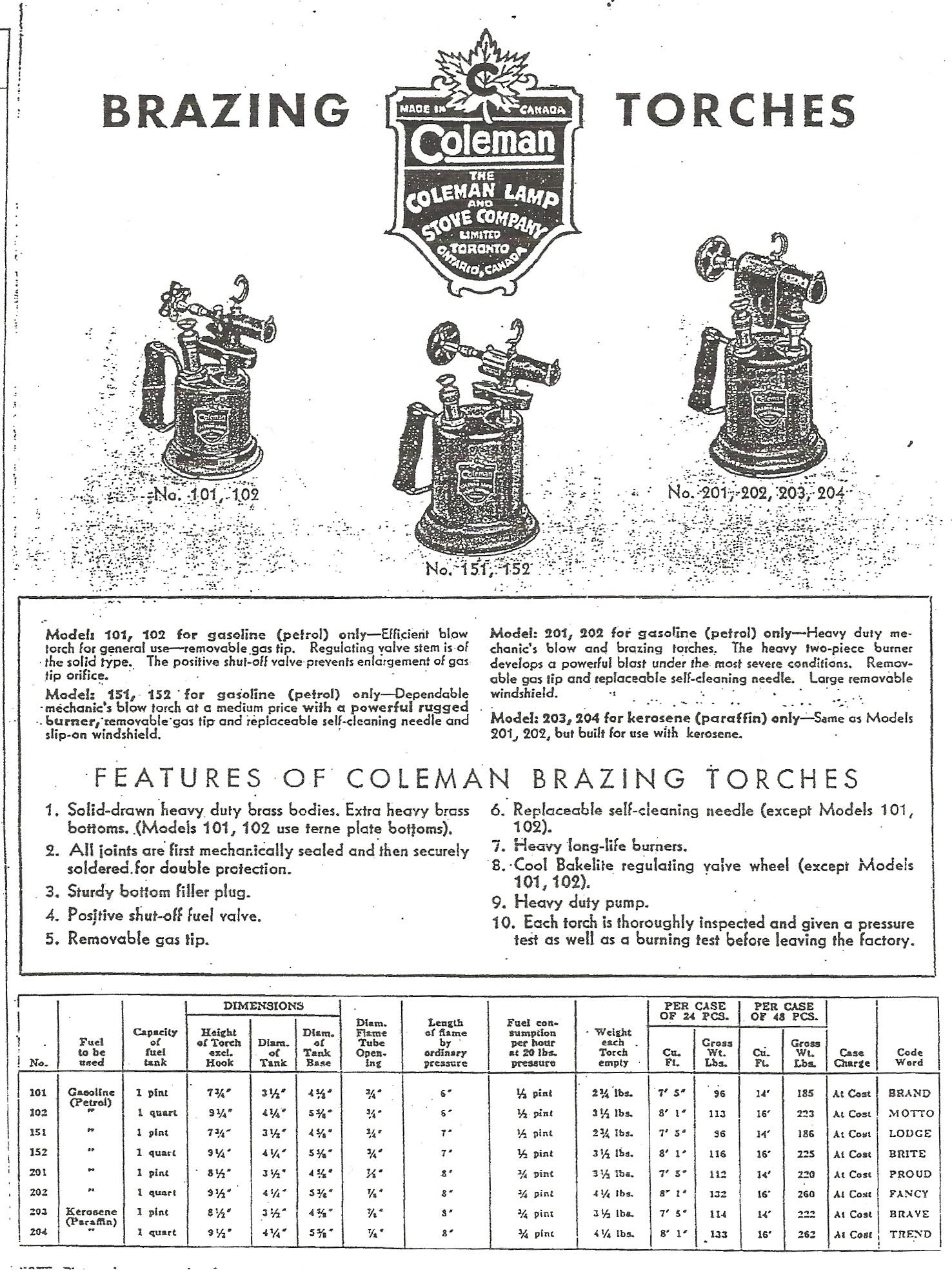 |
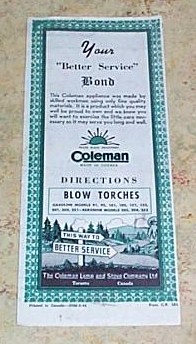 |
|
Coleman example: Model
92 (Butler No 100 equivalent) |
Advertisement
for Coleman Blow Torches. The date is believed to be 1942. |
Advertisement
for Coleman Brazing Torches. Possibly 1940s? Click on to enlarge. |
Coleman leaflet
~ believed
to be 1951. Click on to enlarge. |
|
Coleman
Blow Torches: Brief background, and associations with Butler
|
|
Butler
are believed to have produced - at various times - their full range of blow torches for
the Coleman Lamp & Stove Company Limited, Toronto. The association was a long one,
possibly from as early as 1942 (if not
before) to something approaching 1970? Unfortunately, unlike Coleman US for
which operations and products are well documented - mainly by the International
Coleman Collectors Club - not so much is
known of Coleman's Canadian operations. Coleman opened their Toronto branch in
the mid 1920s. Butler are listed as doing work for Coleman, Toronto, in the 1946 Canadian
Trade Index, and by 1953, Coleman, Toronto are listed as Export Agents for Butler, but as discussed,
nothing is known of Coleman's export activities in this respect.
The
Pressure Lamps International web site describes how after WWII, Coleman continued to expand, and following a resurgence of trade in the
1950s, with facilities in the USA and Canada, had licensing
agreements for manufacture in Brazil, Mexico, Hong Kong and the Middle East.
Lamps (lighting) were also made in England before and after the war. The
Classic Camp Stoves website (article on Coleman, by Bud Michael) describes Coleman's post
war (product) variants to include utility burners for restaurants, farms and trades, blow
torches, home hot water heaters, and special purpose cookers and heaters.
The mention here of blow torches post war fits the Butler / Coleman time
frame,
but, whilst advertisements for blow torches appear (some are reproduced here),
blow torches as such do not appear in any known Coleman product or parts
catalogues, although the Coleman 300 series blow lamps appear in an export
catalogue of around 1948. See below.
The Coleman
blow torch decals (below) were much like that used by Butler,
and indeed, all but what is possibly the earliest example (below left) displayed the Butler name beneath that of Coleman.
Why the (earliest?) decal appeared without Butler's name is not known.
The decals are variously illustrated in the leaflets (above) employing artistic license,
the decal being 'overprinted' on to the
illustrations of the torches, as a decal is never seen in this position on an
actual example. Also to note is that in each
case, the illustrations show Butler's early handle bracket arrangements, believed only ever to have been supplied
and fitted to early (1940s) models that were sold with just the Butler name. See
Variations and dating of blow torch examples for further
discussion.
First
of the advertisements (above centre) is a copy of a Coleman
leaflet which is possibly dated 1942. It depicts what appears to
be a Coleman model 91 (pint) and model 92 (quart). Unfortunately, the 1942 date cannot be substantiated, but if it could, it would
establish a very early link between
Butler and Coleman. Next
is an advertisement for Coleman
Brazing Torches, possibly from the 1940s, listing petrol (gasoline) models
101, 102, 151, 152, 201 & 202, and paraffin (kerosene) models 203 & 204.
Finally,
is a Coleman leaflet, believed to be 1951
(above right) which lists the full range of models, including the
two-quart models 251 (petrol) and 252 (paraffin). See the range
of models produced by Butler (above) for comparison.
|
|
Decals
used by Coleman, with very approximate dates
|
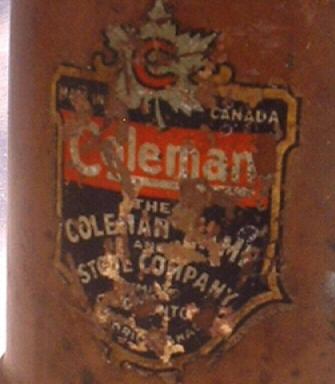
|
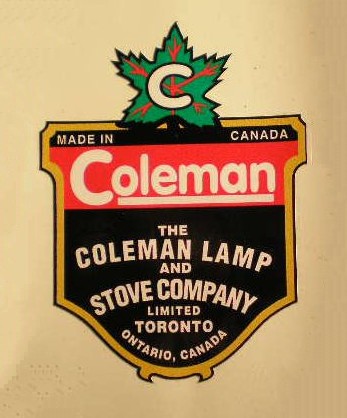
|

|
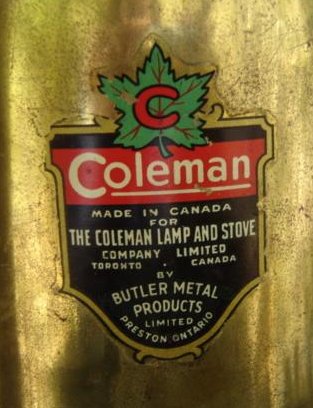
|
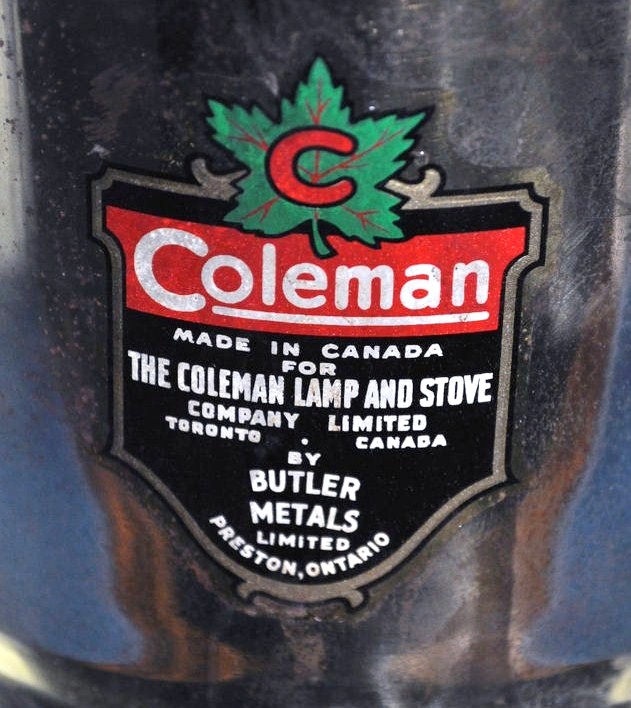
|
|
Coleman
decal, possibly first ever
used. Note there is no mention of Butler.
The example
to the right is a modern replacement or
facsimile.
|
Coleman decal - up to
c1949
|
Coleman decal
c1949 to 1962
|
Coleman
decal 1962 onwards
|
|
To
note here is the obvious similarity between the Butler and the Coleman
decals
|
|
Coleman 'Simplified European Type' paraffin blow lamps: possible
connections with Townson & Coxson Ltd ?
|
|
Of
note is that according to a Coleman Export Catalogue of c1948
(below middle) a range of
paraffin blow lamps (numbered 301, 302 & 303) were produced in North
America. The advertisement
actually states "The first Paraffin Blow Lamp of
this simplified type ever made in North America". A further illustration is shown below
left which appeared on a metal sign / advertisement along with other Coleman
products. It is not known who manufactured these blow lamps, but they were
certainly of a 'Simplified European Type' in that they were clearly based on the classic design
of paraffin blow lamp which had been produced for many years by several makers in -
primarily - Sweden and England. The English maker Townson & Coxson produced paraffin blow
lamps with the trade name Burmos below right, features of which bear a striking
resemblance to the illustrations shown on both the metal sign and in the export
catalogue. However, the only actual examples seen of a 'Simplified European Type'
- models 301 and 302 - are shown
below.
It may be
surmised that there was a link between Coleman and Townson &
Coxson, but even if this wasn't the case it is difficult to believe that Coleman produced (or had produced for them)
these particular types of blow lamp without some form of collaboration with one
or other of the European manufacturers of the time. However, as said, it is not known who
manufactured the 'Simplified European Type'
of blow lamp. It could have been Coleman themselves, but there is no evidence to suggest that Coleman ever produced blow torches
/ blow lamps, despite having the technical expertise and facilities for large
scale stove and lamp manufacture. We know there was some form of connection
between Coleman and Monitor Engineering and Oil Appliances Limited, but was this
relevant? Or were Butler themselves involved? It seems unlikely, so this question will remain unanswered unless further
information comes to light. But the claim that this type of blow
lamp was made in North America is important.
Study
of the export catalogue advertisement (below middle) shows 'overprinting' of the
(earliest?) Coleman
decal (above left: decals used by Coleman).
The same Coleman decal is also seen on the example of what is believed to be a
model 301 below.
|

|

|
%201%20&%202%20pint%20(England)%20-%202.JPG)
|
|
Coleman
metal advertising sign, depicting - amongst other products - the 'Simplified European Type'
of blow lamp.
|
Advertisement
from Coleman Export Catalogue of around 1948, showing the Coleman 'Simplified European Type'
of blow lamp.
Click
on to enlarge.
|
Examples
of a pint and a quart paraffin blowlamp by Townson & Coxson of Birmingham,
England, with the trade name Burmos. These two examples are believed to be of WW2 date,
as the tanks are of steel. Was this the pattern adopted by (or for) Coleman for
their 'Simplified European Type'
of blow lamp?
|
|
Coleman blow lamps: possible
connections with Monitor Engineering and Oil Appliances Limited?
|
|
There are to be found -
though infrequently - both paraffin and petrol blow lamps with the name Coleman-Monitor either attached
to, or imprinted into,
the tank body, as in the examples below. It can only be concluded from this that there was some form of
collaboration between Coleman and Monitor Engineering and Oil Appliances
Limited, of Birmingham, England.
|
 |
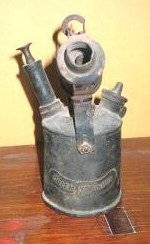 |
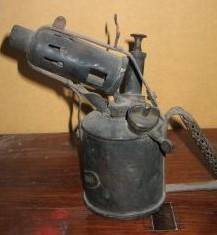 |
 |
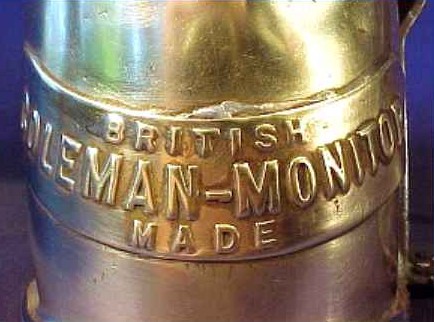 |
|
One
pint paraffin blow lamp with the name 'Coleman-Monitor' impressed
into the tank.
|
One
pint paraffin blow lamp
with nameplate 'Coleman-Monitor'. This, to all appearances, is a version
of a Monitor model 25 or 26.
|
Small petrol blow lamp
with namepalte 'Coleman-Monitor'. This, to all appearances, is a version
of a Monitor model 130 (two variants can be seen with slightly differing burners).
|
|
Coleman
'Hybrid' blow torches
|
|
It is
almost certain that Coleman did not produce the lamps /
blow torch hybrids as illustrated by the examples below. Nor did any other
manufacturer for that matter. These assemblies typically comprise a pressure lantern tank, or sometimes a table lamp tank,
with a mismatched blow torch burner assembly. Often the tank is a Coleman, whilst examples of
burner assemblies seen
range from Butler, Turner, Craftsman (Sears & Roebuck) and others, including
what appears to be a paint type
burner possibly from an early Clayton & Lambert (below right). Some of the examples
seen have handles, often crude affairs as seen with the example below left, though
many
do not have handles at all.
|

|
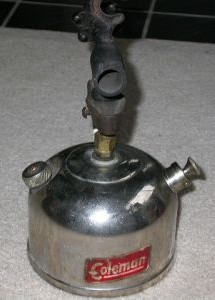
|

|
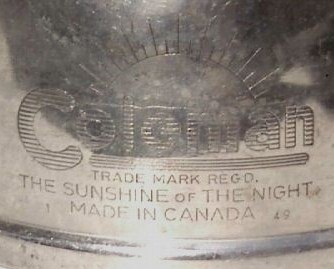
|
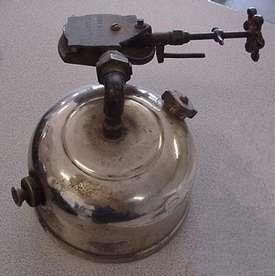
|
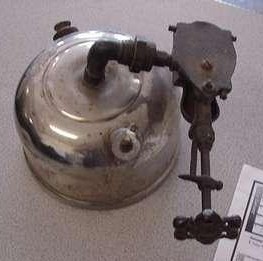
|
|
Two
examples of Coleman 'Hybrid' blowtorches. In both cases a Coleman lamp base with
a Butler burner assembly.
|
Example
of a Coleman 'Hybrid'. In this case a paint type burner assembly which appears
to be from an early Clayton & Lambert.
|
|
Dominion Blow Torches
|
|
Dominion torches were manufactured in Preston, Ontario, and were effectively
Butler torches with a ‘Dominion’ label. As discussed, Butler made
torches for Coleman, and the family likeness between Butler, Coleman &
Dominion - and other - torches, is readily
seen. The Dominion torch leaflet and parts list (below
left) actually illustrates
Butler (or could be Coleman) models, as the Butler (or Coleman) decal can just
be seen on the front of the torch in the photographs of the various models,
particularly the 500 / 501. Very much a guess, but the notation on the
back of the leaflet could date it at 1960.
|
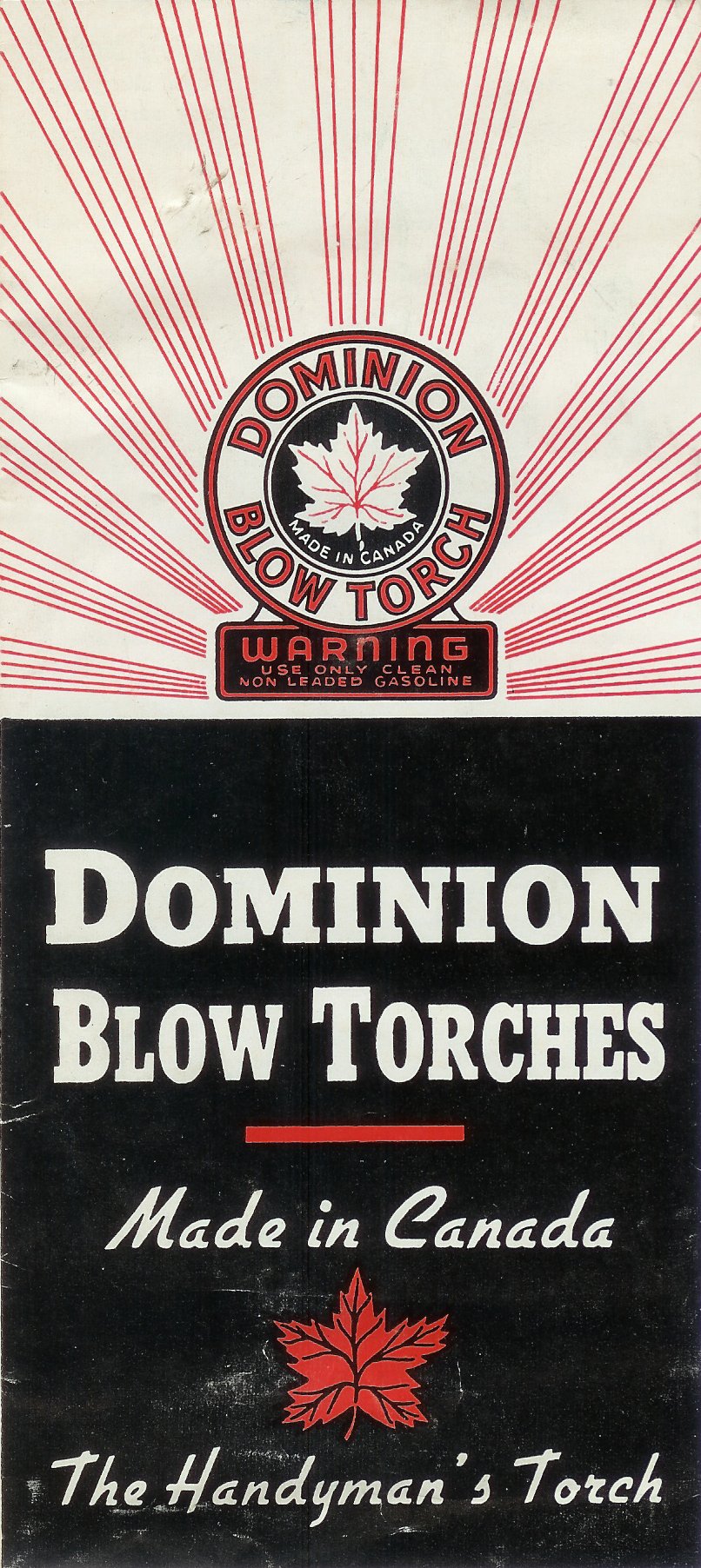 |
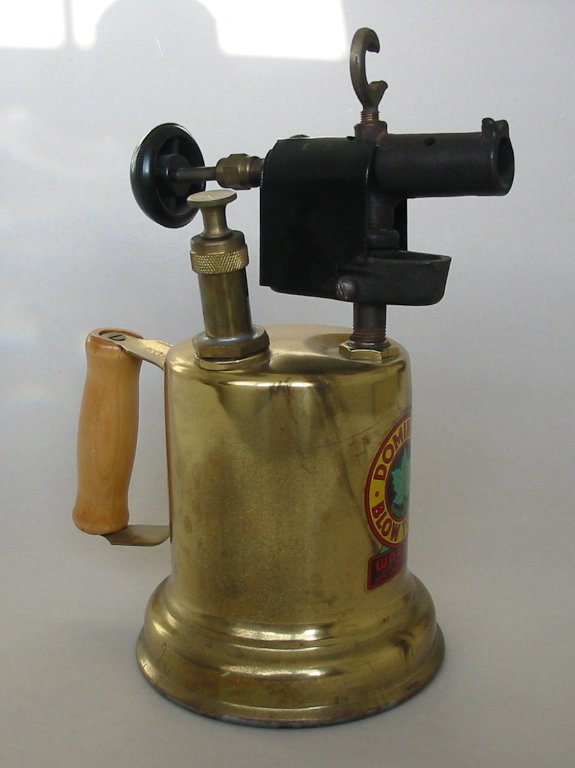 |
 |
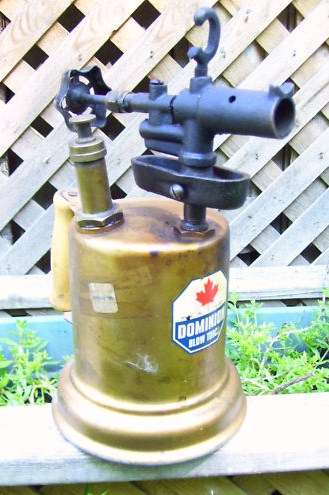 |
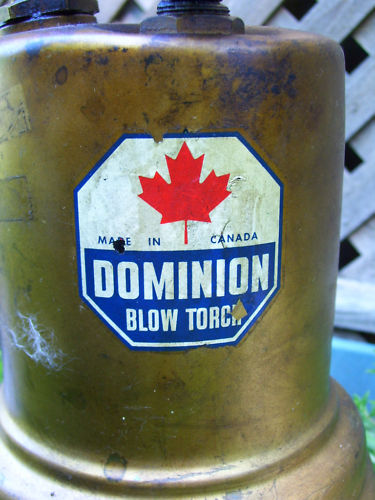 |
|
Dominion Leaflet
~ 1960? Click on to enlarge
|
Dominion
example: Model 504 (Butler No 150 equivalent)
|
Dominion
model 502 (Butler No 100A equivalent) with different (later?) decal
|
|
It
is interesting to note that the very same illustrations of the spare parts shown
in the Dominion leaflet can
also be seen in the Coleman leaflet
above. At this time we know nothing more about Dominion blow torches,
or their direct connections with Butler.
|
|
Engineering Tool
& Forgings Limited (ETF) St Catherine's, Ontario
|
|
Note.
This section has been revised in the light of new research. See Revisions to
Website.
|
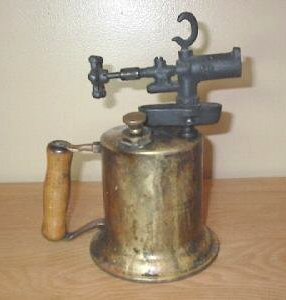 |
 |
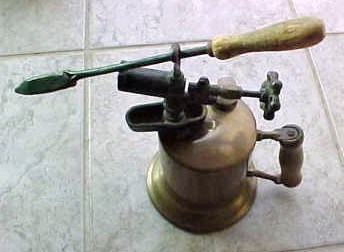 |
 |
|
ETF
100Q (Butler No 100 equivalent) |
ETF
100Q
(Butler No 100 equivalent). Two examples, both with stamped name / logo
(right). |
|
Located in St Catherine’s, Ontario, the Engineering Tool & Forgings
Limited (ETF) ‘brand’ of blow torch was almost certainly produced by
Butler, and
sold under the ETF brand name.
The
ETF name / logo (above right) is stamped on the tank directly behind the handle,
in the same
position as, and in a similar style to, the Butler
example above. It is very likely that the ETF models were contemporaneous with the
earliest (if not the first) phase of Butler Stampings & Machine Screws Limited
production of the 1940s, because in each case the tank was stamped in a similar
position and manner, as well as being fitted with the earlier type
(separate) handle brackets. Also note the use of the clear varnished handle
(as opposed to the red painted handle) in the above examples. See Variations
and dating of blow torch examples above.
Link
to a website relating to Engineering Tool & Forgings
Limited can be found at http://www.papawswrench.com/vboard/index.php?PHPSESSID=
|
|
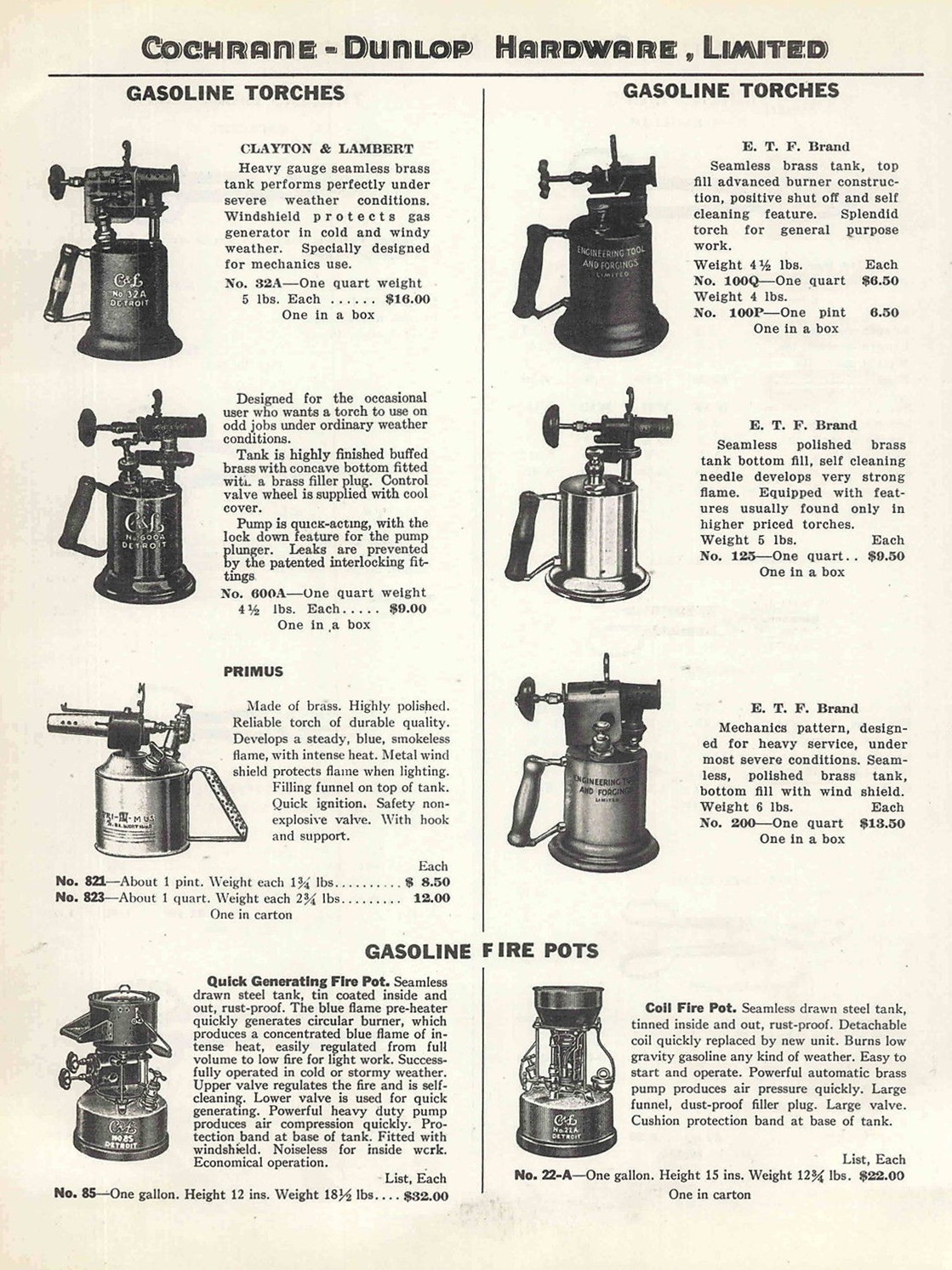
|

|
Note:
Later information (March 2014, see
Revisions to Website) has come to
light in a Cochrane-Dunlop advertisement
for three models of ETF blow torch: models 100Q and 100P (quart & pint
respectively), model 125 (quart) and model 200 (quart). See far left.
The advertisement
is believed to be dated 1939 which does not directly accord with the start date
of 1940 given for
Butler blow torch production. However, as the 1940 date (though
believed accurate) is not confirmed, the two dates (1939 & 1940) are
near enough until (and if) further information emerges.
This early date
also confirms the suggestion above that the production of blow torches for ETF
was contemporaneous with the earlier (if not the first) Butler production.
Further information
(added April 2017, see Revisions to Website)
is the advertisement
for the ETF model No 150, on the immediate left. For whatever reason, this model
number differs from that described in the Cochrane-Dunlop advert, but
would appear to be the equivalent of the ETF model No 125. Possibly a
coincidence, but the ETF model 150 shown is the equivalent of the Butler
model 150.
|
|
Cochrane-Dunlop Hardware Ad ~ 1939(?).
Click on to enlarge
|
Advertisement
/ box label(?) for the ETF model 15. Click
on to enlarge
|
|
National Blow Torch, National Tool Distributors, Toronto
|

|

|
%20-%20a.jpg)
|
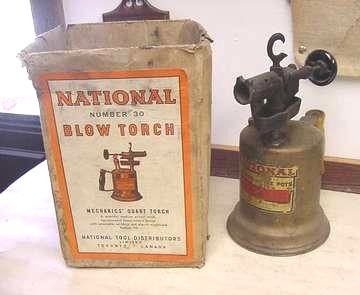
|
|
National Tool No 20 (Butler No 100 equivalent). Two examples.
|
National Tool No
30 (Butler No 150 equivalent)
|
|
Above: Another Butler product,
in this case sold under the National
Blow Torch label, with National as distributors or retailers?
|
%20-%20a.JPG)
|
%20-%20b.JPG)
|
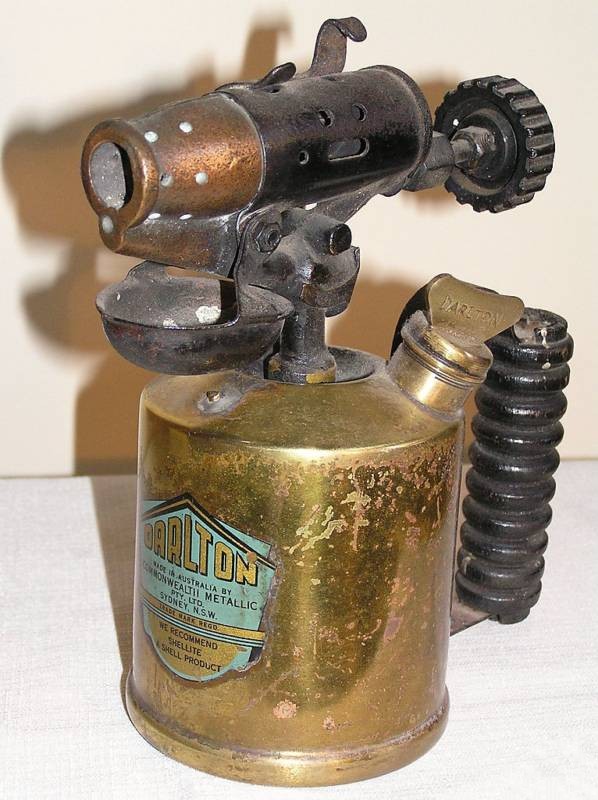
|
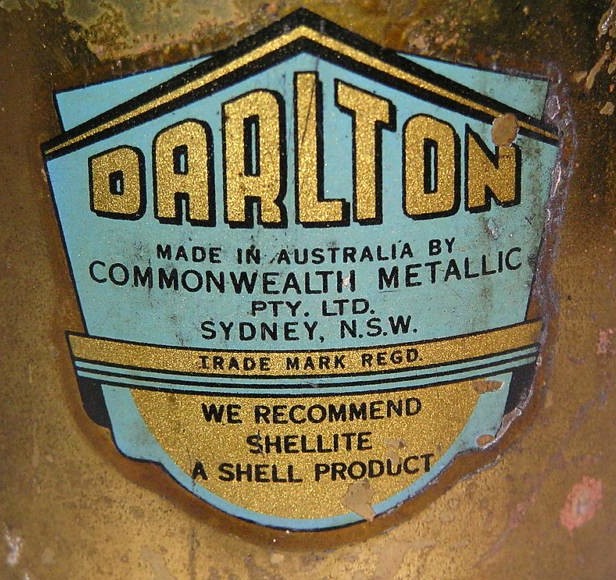
|
Far
left: A Darlton blowlamp with the National label, the same as used on the
Butler made blow torch above, and presumably intended for distribution and
resale under the National name. Darlton blowlamps were manufactured by
Prymace Engineering Co Pty Ltd of Sydney, prior to 1948.
|
|
After
this time the manufacturer is listed as Commonwealth Metallic Pty Ltd,
Sydney, so possibly the outcome of a takeover. The blowlamps produced
by both of these companies were distributed by Darlton Products Pty Ltd, of
Sydney. Of all the manufacturers in Australia, Darlton produced the
greatest range of models.
|
|
Darlton (Australia)
blowlamp with the National Torches label, above left. To the right, much the same
blowlamp with the Darlton label
|
|
Teco -
Eaton's of Canada
|
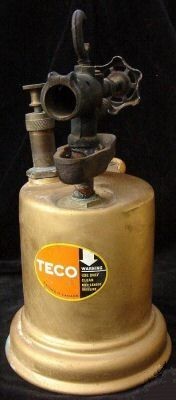 |
 |
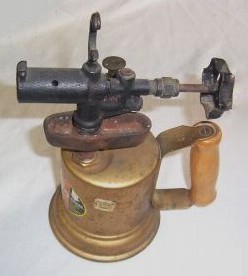 |
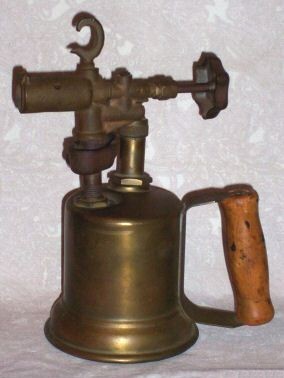 |
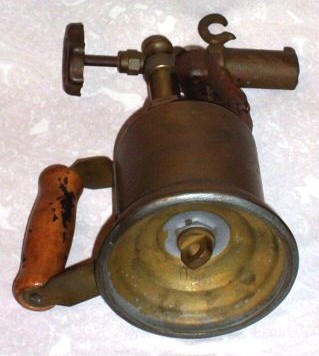 |
|
TECO Model 52 (Butler No 100A
- quart - equivalent
|
TECO Model 53? (Butler
No 100A - pint - equivalent). Two examples.
|
|
Eatons were actually Canada's largest retail chain store
until their bankruptcy in 1999. The photos show
a ‘TECO, Eaton’s of Canada’
Model 52, which is effectively a Butler model 100A (quart), and a Model 53, effectively a Butler model 100A (pint).
The Eaton's model numbers (52 and 53) are as yet unconfirmed, yet
curiously they relate to the equivalent Dominion models with numbers 502
and 503. Just a coincidence?
|
|
Other Canadian Blow Torch Manufacturers / Retailers
|
|
Eaton's Dominion
|
|
The gasoline torch pictured
below left, believed
to be from 1932, and with the label Eaton’s Dominion Torch
(See also TECO - Eatons of Canada, and Dominion, above) clearly has links to the British manufacturer,
T E
Bladon & Son Ltd., Birmingham. There is an unmistakable similarity in the general appearance
and use of components between the Eaton’s torch and Bladon's ‘Diamond
Brand’ - and later - torches. So we can be reasonably sure that Bladon at one time made
torches which were sold or distributed in Canada by Eaton’s. The other
possibility is that these torches were manufactured under some form of licence
in Canada, but this would seem unlikely. What we do know is that Bladon's
Diamond Brand torches were produced in Birmingham from c1926 to the 1930s,
and therefore certainly Butler’s start date for blow torches.
|

|
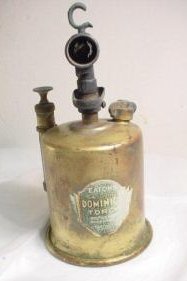
|
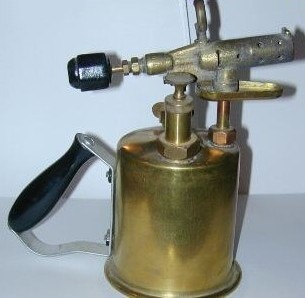
|
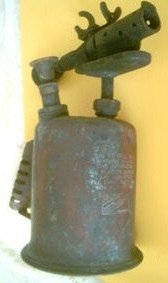
|
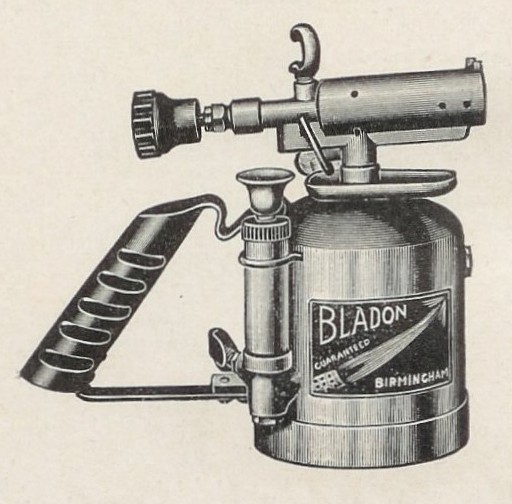
|
|
Eaton's Dominion Torch - possibly 1932 (similar to Bladon's B64)
|
Bladon's Diamond
Brand (unknown model)
|
Other (probably later) Bladon models (model B64 to the right)
|
|
Note the similarities. Although curiously, the Eaton's torch displays features
from both the Diamond Brand, and other, Bladon torches. It is also interesting
to note that the Diamond Brand torch pictured (centre) is more in the American style of
gasoline torches of this period, in that it has the pump mounted in the top of
the tank, unlike the Eaton's which has the typical Bladon side-mounted pump, and
the burner is very much American in style. However, we should be cautious when drawing such comparisons, as Bladon were known
for producing various blow lamps / torches which were not
necessarily cross-referenced or listed in their literature.
|
|
The Brown Boggs Co Ltd - Hamilton, Ontario
|
|
At
least two model variants can be linked with this manufacturer, as they display a
soldered brass name plate with the Brown Boggs name. They will probably have pre-dated Butler blow torches,
but unfortunately no other information regarding Brown Boggs as a
manufacturer of blow torches is
available at this time, and there are no blow torches listed in the 1912
catalogue below centre. An example of a soldering iron (copper) stamped
with the name Brown Boggs below right, is, however, in the Catalogue. http://openlibrary.org/books/OL22862436M/The_Brown_Boggs_Company_Limited.
Note that 'Lake Superior' was a brand name for all their soldering coppers.
However it
should be noted that the German manufacturer Barthel (who sold blow torches in the
US through their agent the Globe Gaslight Company of Boston) are
believed to have manufactured a very
similar looking kerosene blow torch around the 1910s (model Neukarneol).
In addition, Clayton & Lambert, and A E Lovett Co, both US
manufacturers, also listed the Barthel model, or one very similar to
it. It could therefore be
argued that Brown Boggs bought in their blow torches from one of the
aforementioned companies, and applied their own name plate. That said, the handle
on the known Brown Boggs examples is, for whatever reason, of a different form.
So perhaps the jury is out on this one!
Brown
Boggs are still in existence - based in Toronto. See http://www.brownboggs.com/history.htm.
|
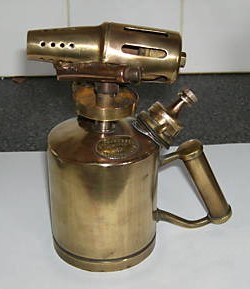
|
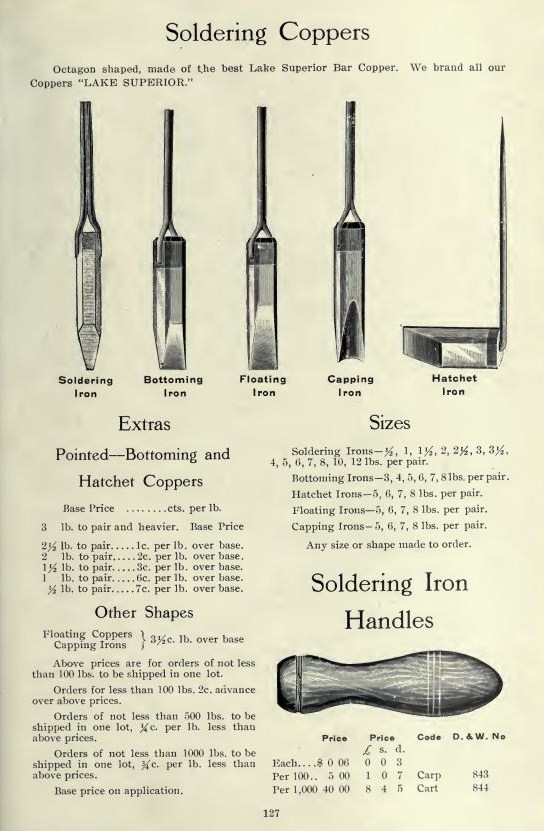
|

|

|
|
Paraffin
blow torch with Brown Boggs name plate
|
Extract
from Brown Boggs catalogue of 1912. Click on to enlarge.
|
Example
of Brown Boggs 'Lake Superior' soldering iron
|
|
Canadian Hauck Burner Co Ltd - Port Hope, Ontario
|
|
The Canadian
Hauck Burner Co Ltd - it can only be assumed - had a connection at some
point in time to the Hauck
Manufacturing Company of Brooklyn, NY. For background information to the
latter named company see, for example https://mycompanies.fandom.com/wiki/Hauck_Manufacturing_Company
and http://blowlamp.co.uk/MY%20WEBS%20~%20Leaflets%20etc/Hauck%20Flame-Guns.pd
|
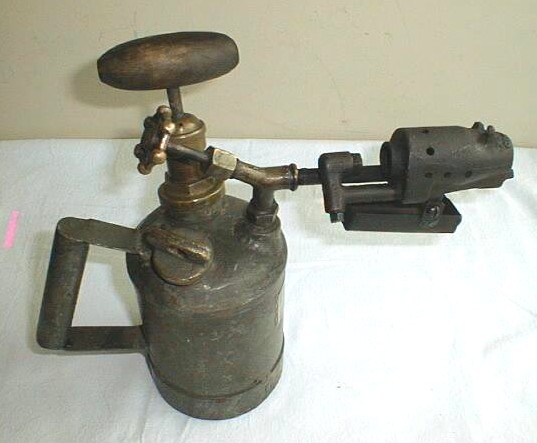
|
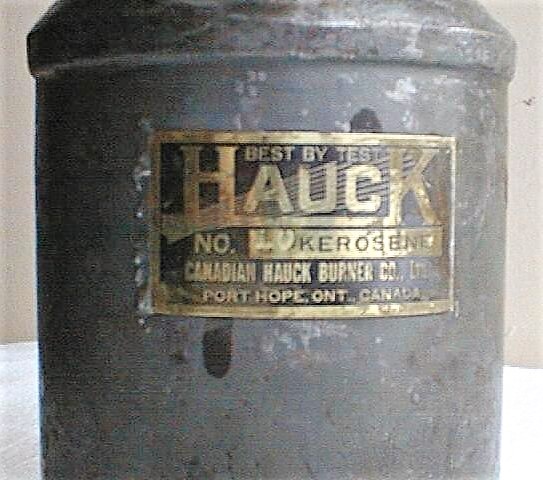
|
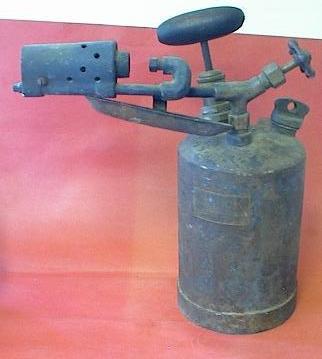
|

|
|
Canadian Hauck No 10
Kerosene
|
Canadian Hauck No 10
Kerosene: Name plate (click on to enlarge)
|
Canadian Hauck No 14
Kerosene
|
|
Nothing more is
known about the Canadian Hauck Burner Co Ltd at this time, despite inquiries by
the author to the present Hauck
Manufacturing Company
|
|
Information Sources and Acknowledgements
|
|
As there has
been no direct
access to the majority of the information (as the author does not live in
Canada), it has only been possible to construct this brief history with
the assistance of a few very helpful people in Canada, as well as the searching of a
large number of websites too numerous and - in many cases - too obscure to
list; and access to the author's own - and limited - items of primary source
material. Because of the
fragmentary nature and diverse sources of much of the information, inevitably
some of it may conflict, and therefore the author accepts all responsibility for any
errors or inaccuracies that may have resulted.
Suzanne
Beauvais (Canada Science and Technology Museum)
was my main source of archived
& background information, and I am very grateful to her for taking the time and
for having the interest to search out a lot of information, as well as conveying
it to me via eMail and post. Without this help,
this project would never have got off the ground.
Jim Quantrell
(City of Cambridge, Ontario, Archives) sent me an
outline history of Butler, extracted from a business history which he wrote in 1988. This provided me with an indispensable framework on which to build.
Mary Smith
(Curator, St. Marys Museum, Ontario) gathered together a lot of very
useful background information for me, with particular reference to Maxwell Ltd,
and the company's links to Butler. This included taking the trouble to contact
people who had been directly connected to Maxwell.
Laura Lamb (Hamilton Library) took the
time and trouble to search out all the information on William Butler's history
during the time he lived and worked in Hamilton, Ontario.
Donna Binsted
(Meaford
Express) provided very useful background information, with particular reference to Meaford
Steel.
Dave Mather (The Meaford Connection)
provided background information and a useful insight into the
link between Butler and Meaford Steel.
The
Corporation of the City of Cambridge
website.
Vintage
Blowtorches, An Identification and Rarity Guide, by Ronald Carr, Charles
Smith & Graham Stubbs. Information relating to the Coleman Lamp & Stove
Company, the Globe Gaslight
Company, Barthel, and Brown Boggs Co Ltd.
The
Blowlamp Society. Information relating to Darlton blowlamps, Australia.
McGill
Digital Archive: Canadian Corporate Reports.
Reference to Mindustrial
Corporation
Roger Kingdon (blow torch enthusiast, Canada): Photographs of
Engineering
Tool & Forgings Limited blow torch.
The International Coleman Collectors Club kindly supplied some of the items
of Coleman literature.
Region
of Waterloo Museums & Archives kindly gave permission for
inclusion of photograph dated April 1948 showing Butler Stampings & Machine Screws Limited
works / offices.
Butler family history.
For those
interested, perhaps family historians, comprehensive listings for Hamilton including
business / residential addresses, can be found in Irwin’s
/ Vernon’s
City of Hamilton Directories
between c1887 and 1956.
The Family Search
website also provides useful information about the Butler family https://www.familysearch.org/search/
. An account is required, but it is free to use.
|
|
Collection
(past & present) |
 |
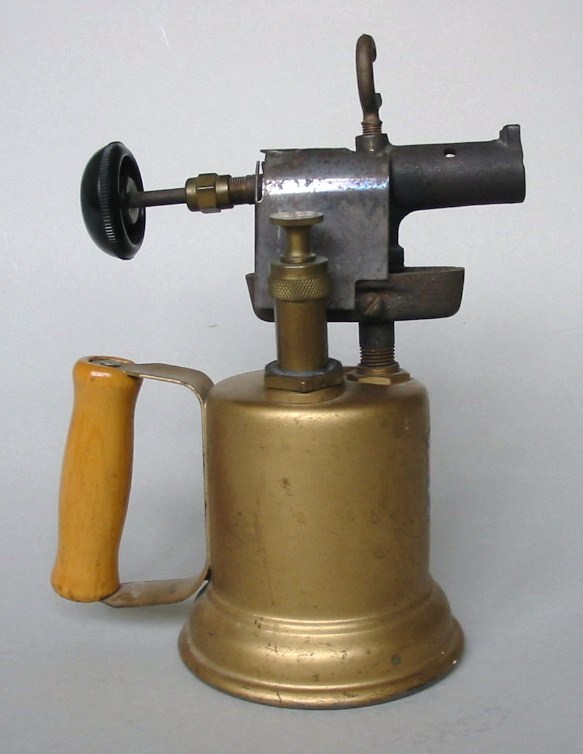 |
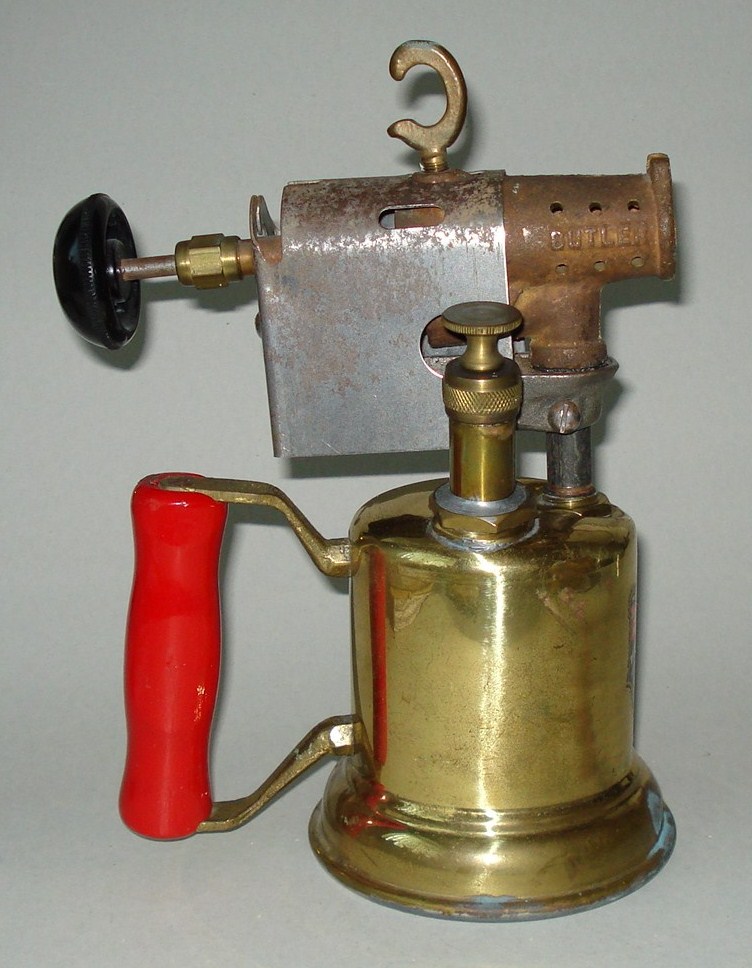 |
 |
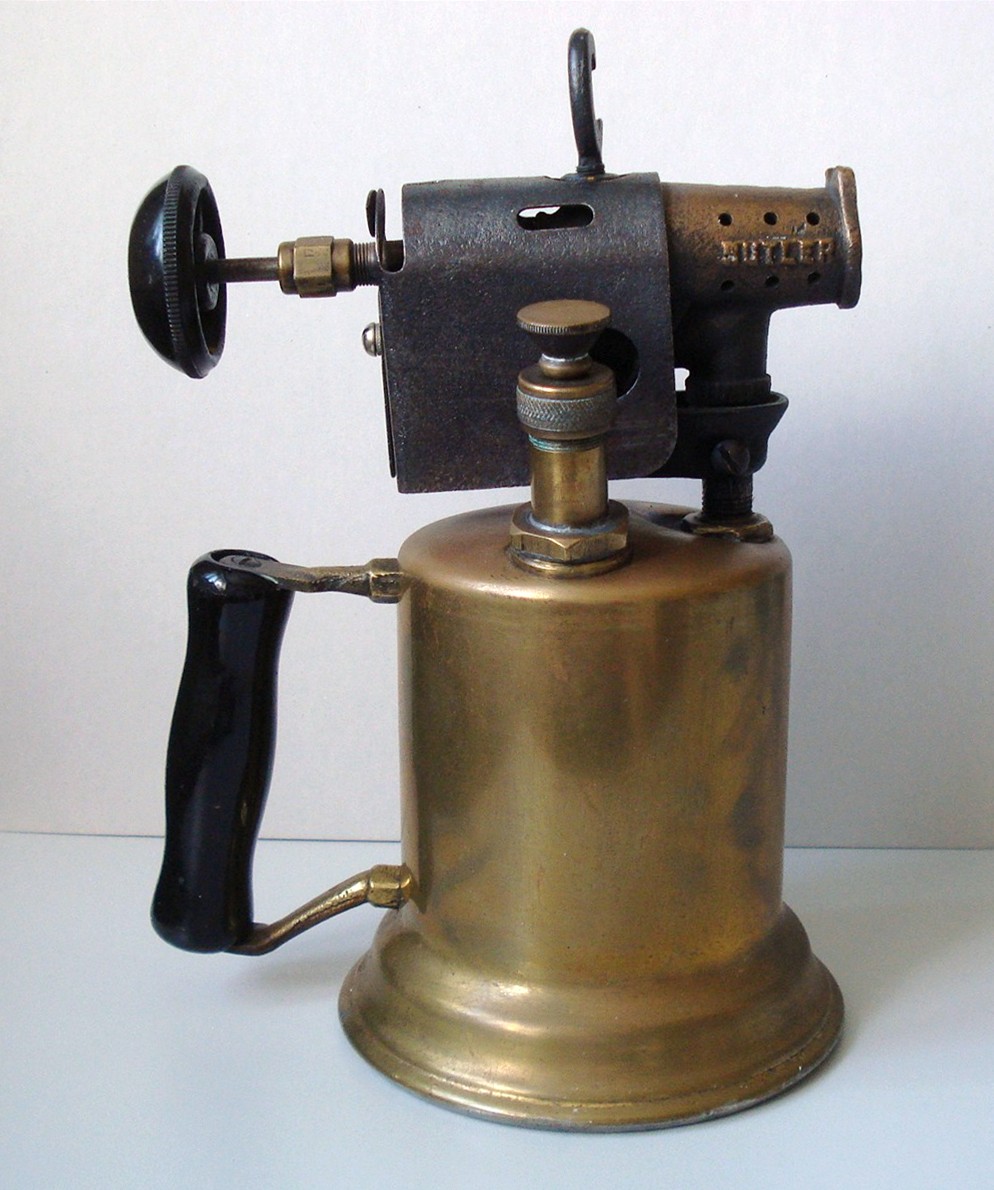 |
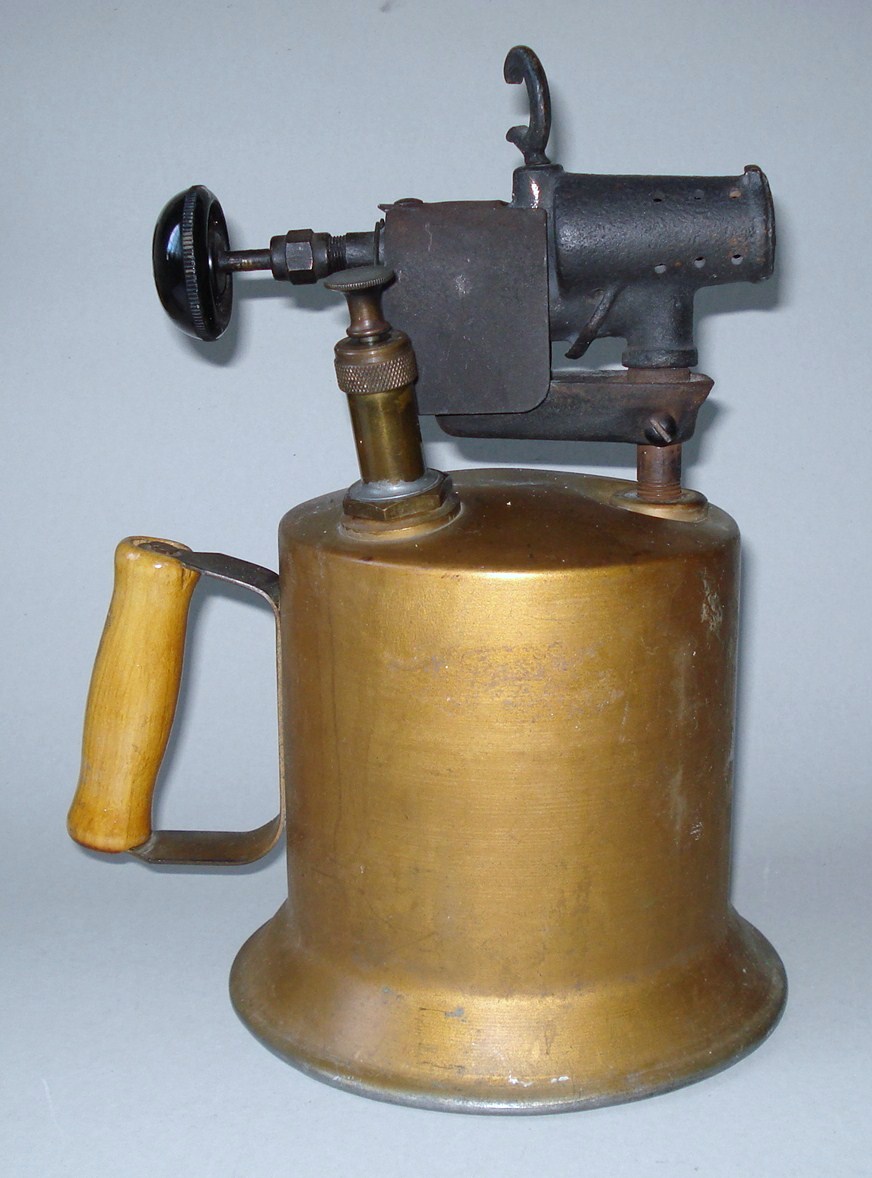 |
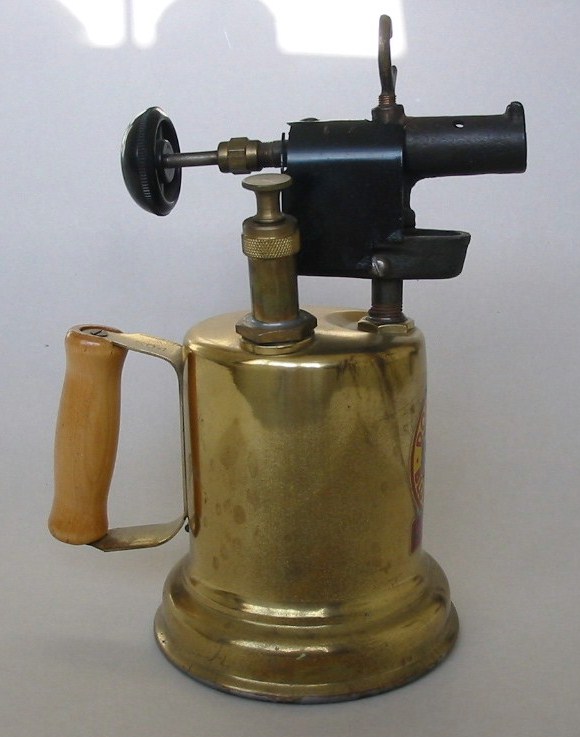 |
|
Butler
150
(Pint) |
Butler
150 (Pint) |
Butler
200 (Pint) |
Butler
200 K (Pint) See "200
K" mark |
Butler
200 K (Quart) See "200 K"
mark |
Butler
200S (Two Quart) |
Dominion 504
(Quart)
|
|
Feedback /
Comments
|
|
Any
feedback, comments, corrections or additional material would be very much appreciated.
Please visit the contact
page
|
|
Revisions / Updates to Website |
|
March
2014:
The Butler History has been revised accordingly. (1) Information relating
to Engineering Tool & Forgings Ltd (ETF) has been added. See ETF,
and also "The range of
models produced by Butler for themselves and for others", where
the ETF model numbers have been added. The ETF information also suggests a
start date of 1939 for Butlers' blow torch production. This suggested date
has been added to the section on Start
of Blow Torch manufacture, and elsewhere, where the start date occurs.
(2) A photograph of a
Coleman model 302 has been added. See illustrations of the Coleman
300 series. The note relating to the Coleman 300 series has been
revised accordingly. (3) Information relating to the materials of
construction of the tanks of Butler blow torches has been added. See
"Butler
blow torch tank: materials of construction, and finishes". October
2014: (1) Minor revisions to the notes on Coleman blow torches / blow
lamps. (2) Link to the Blowlamp.co.uk
Home Page added. January
2015: Site maintenance; October
2015: Error correction; 08 June 2016: Site maintenance. April
2017: (1) Site layout completely updated. (2) Revisions
to contents (home) page. (3) Advertisement / box label for
ETF
model 150 added, and reference made to this model in the "range of
models produced by Butler" chart. (4) Photo of Canadian
Government ordnance mark on Butler 200S added. (5) Butler
advertisement dated 1949 added. Date range for name change to Butler
Metal Products Ltd amended accordingly. (6) Variations, and
dating of blow torch examples section: correction to handle illustration. (7)
New sections added: A note about part numbers; model number markings;
markings to burners / the "200 K"
mark. (8) National blow
torch: Darlton (Australia) blowlamp, sold under the National label. (9)
Links and web addresses updated as necessary. (10) Collection
(past & present): Addition of the "200 K" reference to
appropriate photos. June
2023: (1) General site maintenance. (2) Introduction
updated. (3) Section "William
Butler: Early years, Hamilton, Ontario"
renamed and updated. (4) Photograph
dated April 1948 added, showing Butler Stampings & Machine Screws Limited
works / offices, (courtesy of the Region
of Waterloo Museums & Archives). (5) Section "Post
War & !950s" updated. (6) Section "The
1960s (and the Maxwell connection)" updated. (7) Section Chronology:
Summary of approximate dates & setup of Company
updated. (8) Section Engineering
Tool & Forgings Ltd (ETF) St Catherine's, Ontario updated.
(9) Section Links
updated. |
|
Copyright: A
note from the author
|
|
For
articles such as this, where it is impractical to gather all the information
from primary sources, much of the material, including a number of illustrations
and photographs, is sourced from the Internet. However, such information, from
whatever source, should not simply be "cut and paste" (unless clearly
noted as such, and acknowledged). Copying such "blocks" of information
is effectively plagiarism; it can take such information out of the context in
which it was originally intended, which can mislead and sometimes compound
errors. Where possible, the principle of "fair use" of
information is herewith employed. However, copyright laws do exist for
very good reasons, and the owner of photographic or written material has every
right to object to its "re-use" for whatever reason. If anyone
objects to the use of any information or illustrations within this article, or
indeed anywhere on this website, please make
this known and it will be rectified as soon as possible.
|
|